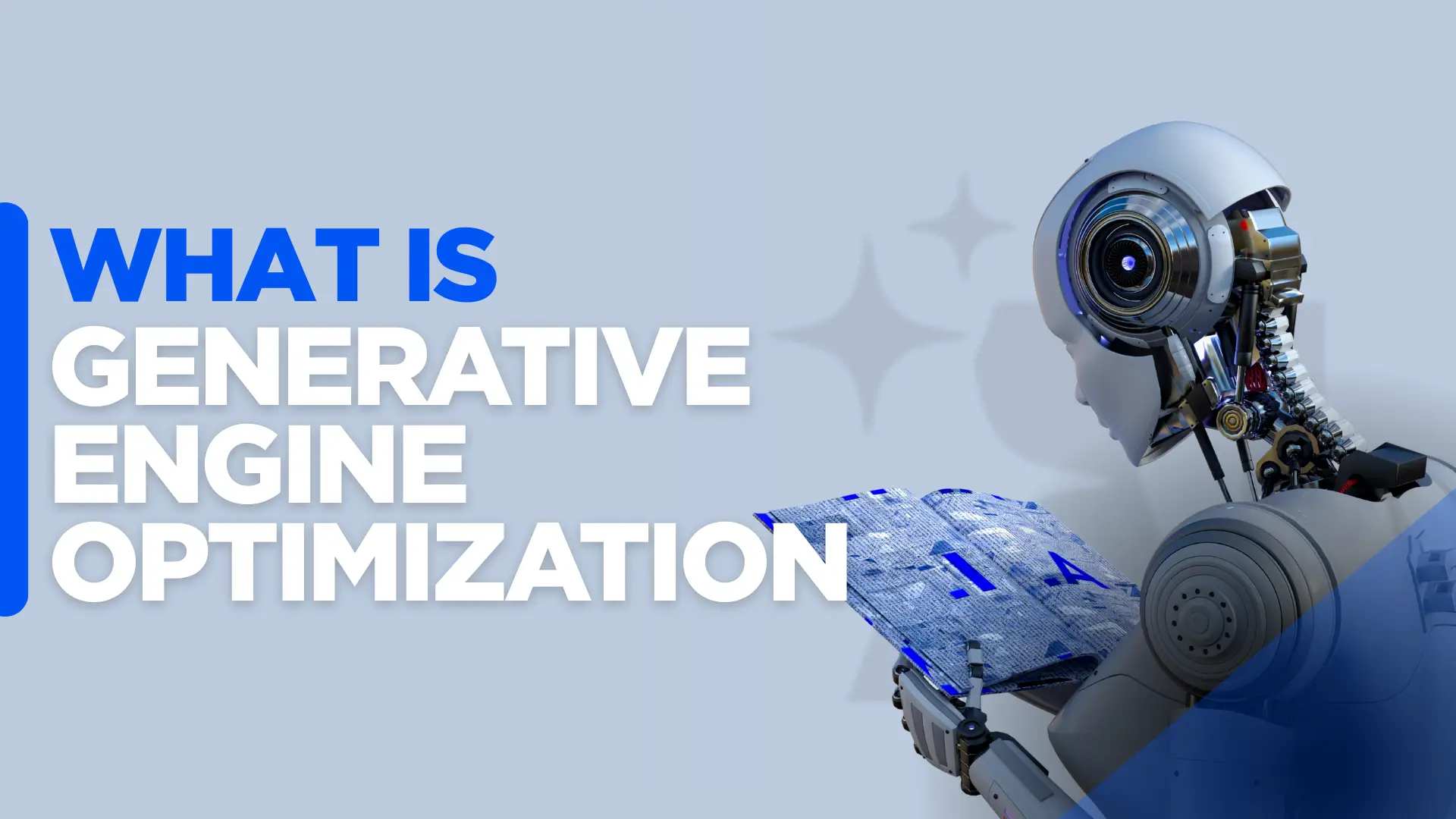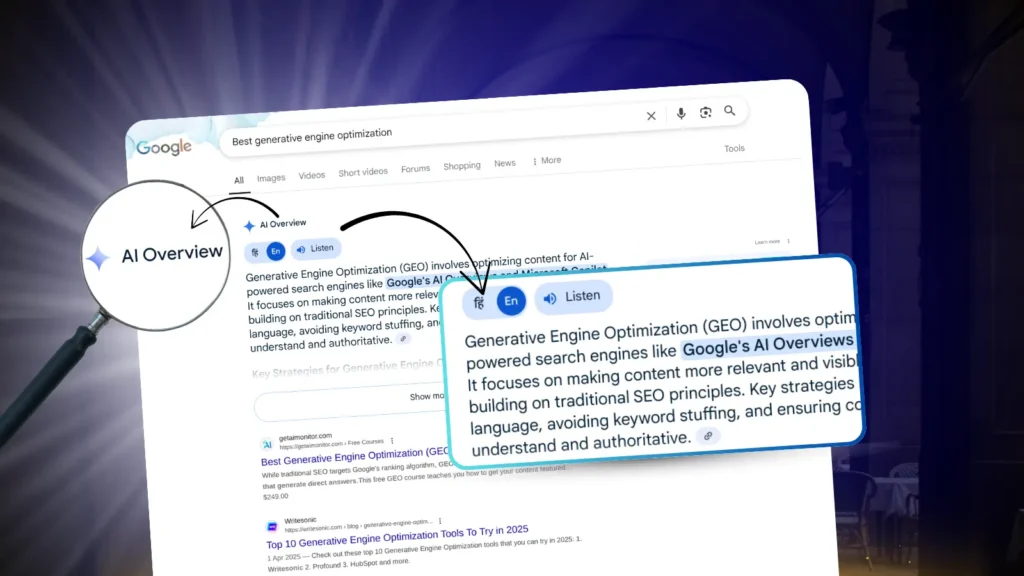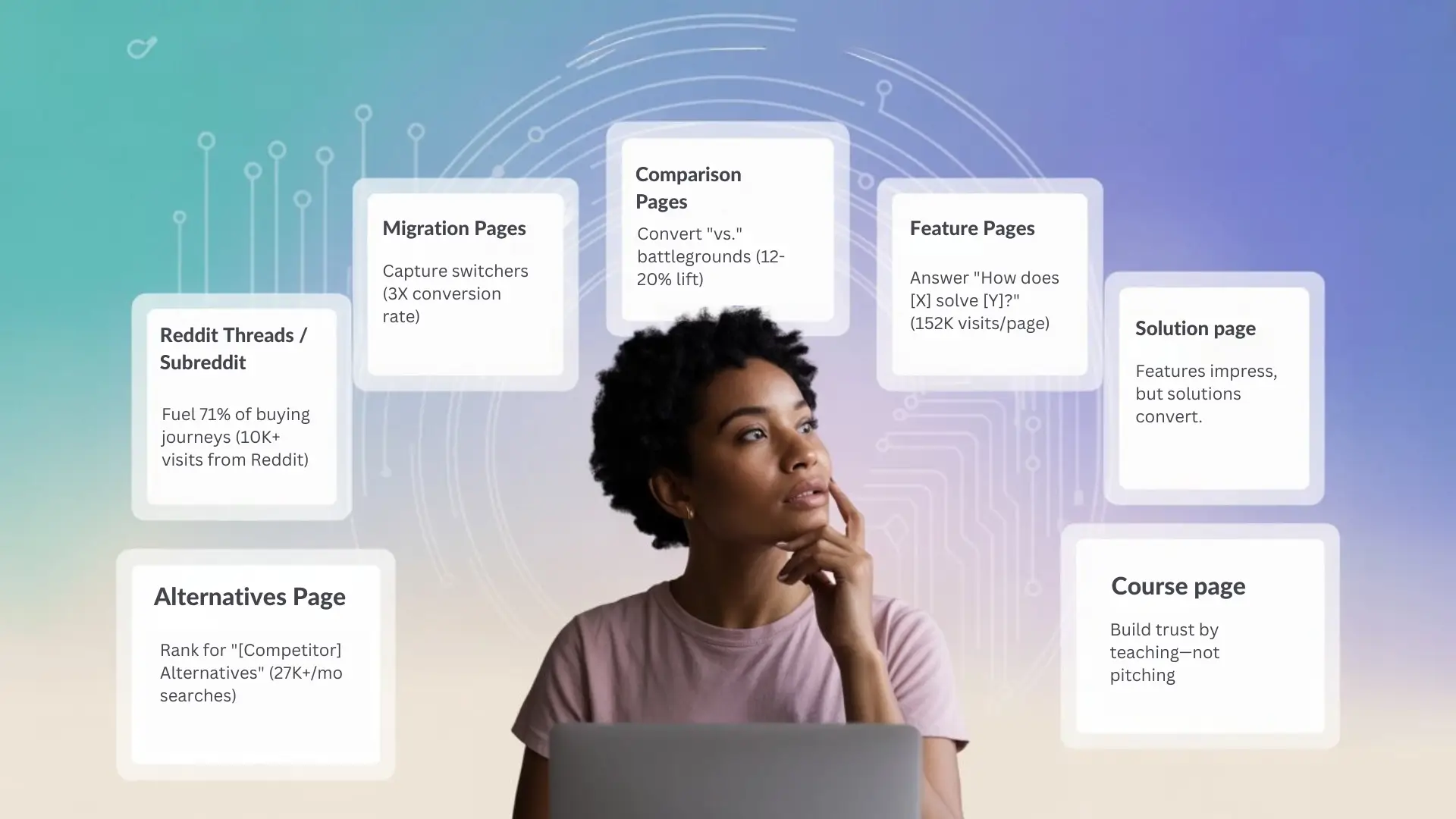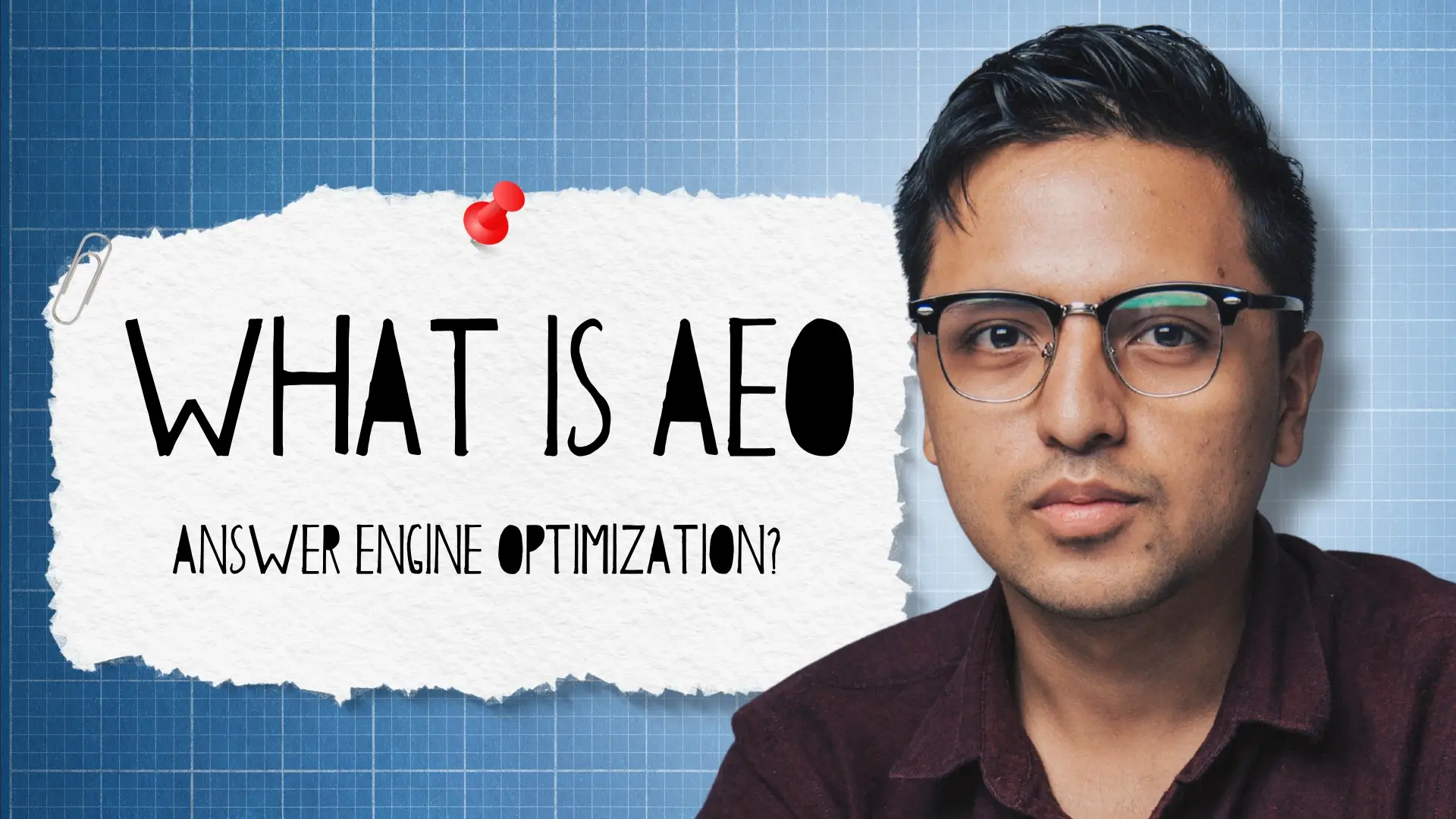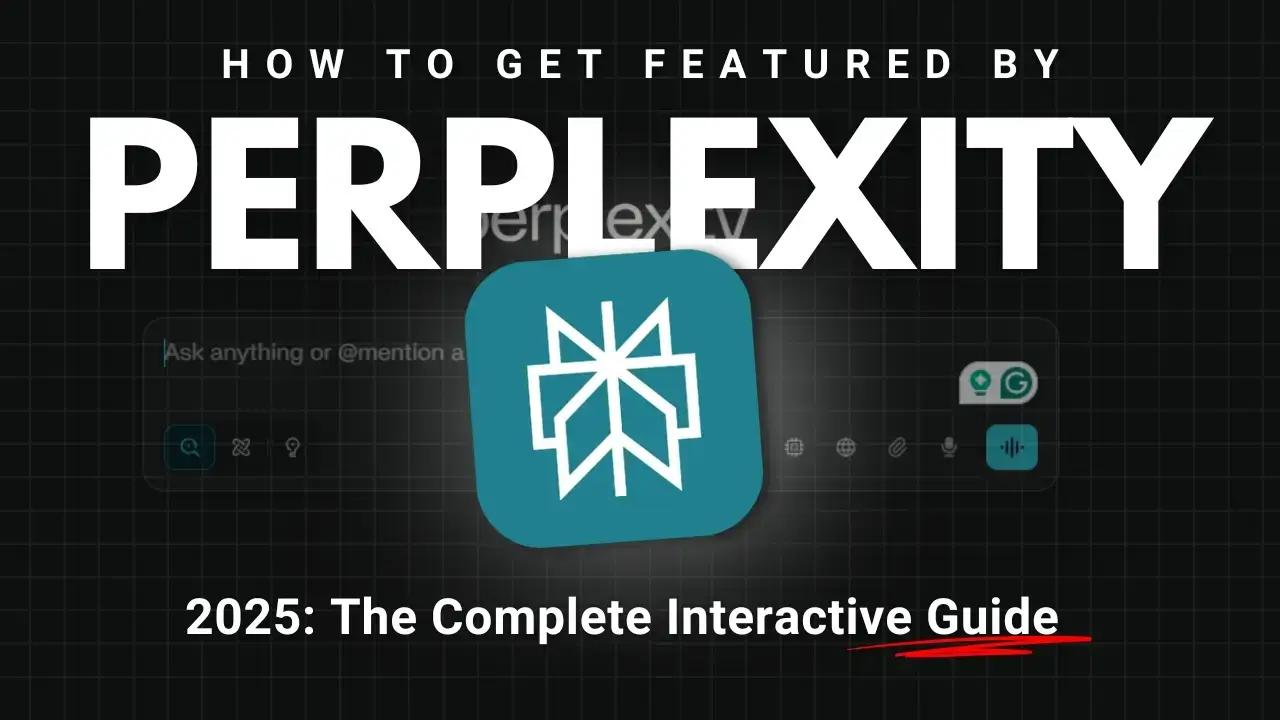Why GEO Is a Game-Changer for Marketers in 2025
The rise of “zero-click” answers is fundamentally reshaping the value of traditional Search Engine Optimization. Even if your site ranks at the top for a keyword, it no longer guarantees consistent traffic. AI-generated responses are increasingly satisfying user intent without sending visitors to your website: changing how visibility and engagement work in real time.
| 70% users trust AI | Rise of Zero-Click Searches from 56% to 69% | AI Lead Conversion rate 4.4× | CTR for #1 Spot Plummets 34.5% | GEO Competitive Advantage +40% |
|---|---|---|---|---|
70% of consumers already trust generative AI results, and 79% will use AI-enhanced search within the year1 | No Clicks From Google Grew From 56% to 69% Since AI Overviews2 | Leads generated from AI-driven recommendations convert up to 4.4 times better than those from traditional organic search traffic. AI Monitor Data, 2025 | A 34.5% reduction in CTR for the top result where AI Overviews appear (March 2025 vs. March 2024)3 | Early Generative Engine Optimization (GEO) adopters report up to a 30–40% increase higher visibility in AI-generated responses through strategic content and entity optimization 4 |
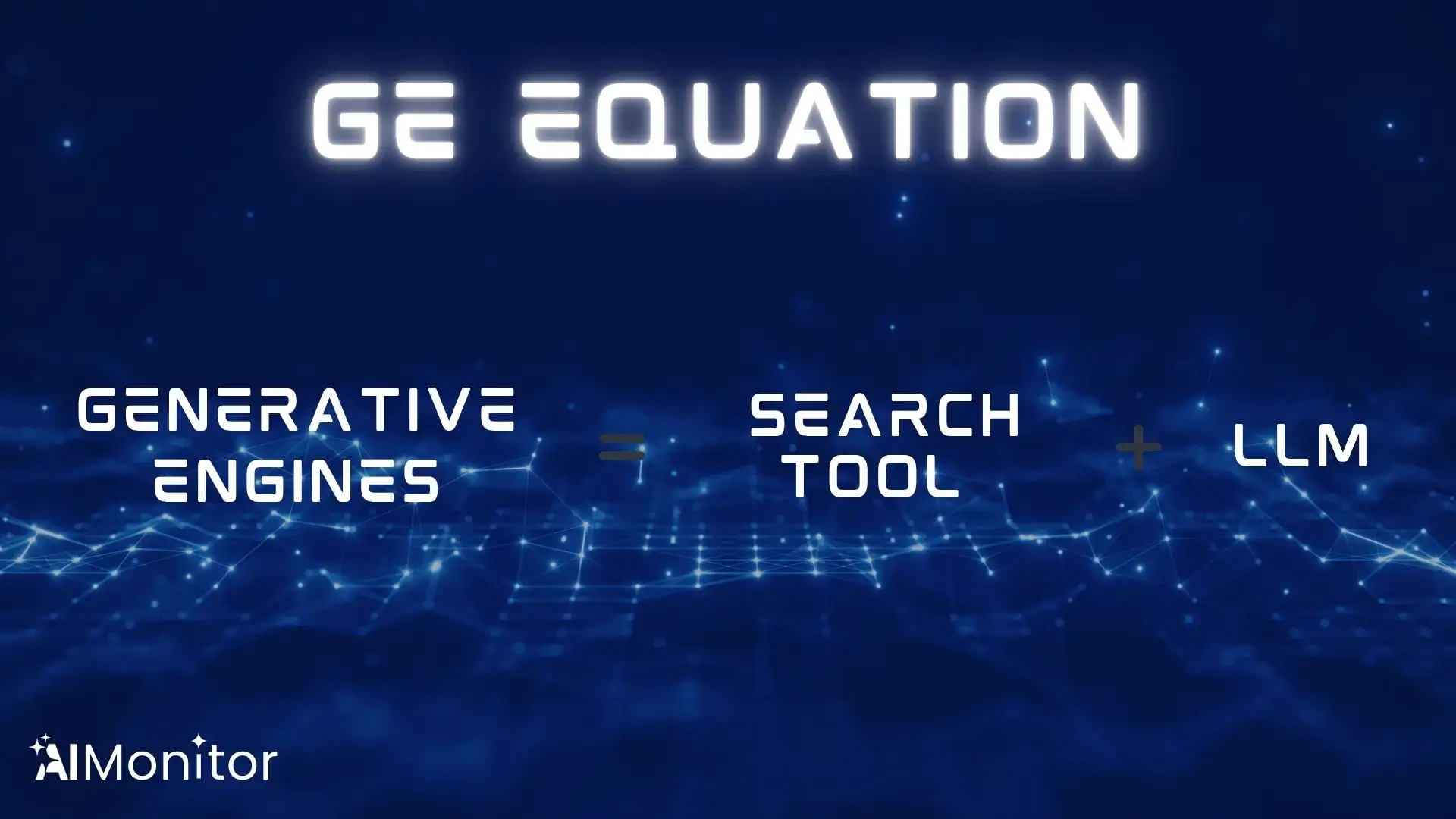
These numbers make it clear that Generative Engine Optimization (GEO) isn’t replacing SEO; it’s evolving and improving on it. With nearly 70% of searches projected to end without a click by the end of 2025, traditional SEO’s keyword-first approach is no longer enough. Where SEO targets rankings, GEO targets AI synthesis, requiring content that’s credible, structured, and context-rich so it can be surfaced directly in AI-generated answers.
The shift is already reshaping how the traffic flows. Studies show the #1 organic result can lose over a third of its clicks when an AI Overview is present. In this new reality, the brands winning visibility are those which are optimizing for AI-powered engines. Early GEO adopters report up to 40% higher presence in AI generated responses, and leads from these sources convert 4.4× better than the traditional organic leads.
This isn’t just another SEO update it’s a real turning point. Think about it: companies that don’t adapt, risk being left behind while competitors dominate AI-generated results. The future of search isn’t just about ranking high anymore, it’s about being quoted, recommended, and embedded in AI-driven insights.
Here’s the exciting part. I’ve been working hands-on with Generative Engine Optimization (GEO), and I know it can feel overwhelming first. That’s why I created one of the first comprehensive GEO courses to guide anyone step by step and make it easy to start applying these strategies right away. So far:
- 2,000+ learners have already gained practical, actionable insights
- 96% completion rate yes, people are actually finishing the course and applying what they learn
In this guide, you will learn:
- What Generative Engines are and how they work – Understanding platforms like ChatGPT, Google AI Overviews, and Perplexity, and how they source and synthesize answers.
- What is Generative Engine Optimization (GEO) and why it matters in 2025 – How optimizing for AI-generated answers is becoming as crucial as traditional SEO.
- How GEO works in AI-driven search – The behind-the-scenes process that determines which brands get featured in AI responses.
- Challenges of GEO – From tracking AI mentions to measuring impact and staying ahead of algorithm changes.
- How to do Generative Engine Optimization – What we’ve learned from real-world campaigns and experiments.
- Best GEO techniques – Proven strategies to increase your chances of being cited, recommended, and embedded in AI answers.
- The benefits and opportunities for businesses – Why early adopters will gain long-term authority and visibility.
- What's the Best Generative Engine Optimization Strategy
What is Generative Engine Optimization and How to implement it ?
Generative Engine Optimization (GEO) is the practice of optimizing your content so AI-powered platforms like ChatGPT, Google’s AI Overview, Perplexity AI, etc. can recognize, cite, and feature it in their AI-generated answers. Unlike traditional SEO, which focuses on ranking on search engine result pages, GEO ensures your content is trusted, referenced, and embedded in AI-driven insights.
The big Difference between SEO vs GEO? SEO is about ranking higher in search results to bring people to your website. GEO takes it a step further it’s about becoming the source large language models (LLMs) turn to when they answer someone’s question. That’s a huge shift. Now, visibility isn’t just about being found; it’s about being the trusted voice inside the AI interface.
Think about it AI is changing how people search for answers. Users no longer just click links; they want direct, reliable insights from trusted sources. That’s where GEO comes in. By structuring your content clearly, adding credible references, and making it AI-friendly, you’re not just improving visibility you’re becoming a voice that AI actively
What Are Generative Engines?
Generative engines like Perplexity, Google’s AI Overview, and ChatGPT are AI-powered search tools that combine real-time web data with advanced language models to deliver concise, expert-level answers instead of just a list of links.
Think of them as a hybrid between a search engine and an AI assistant. They present the information you need upfront, fully synthesized, so you don’t have to click through multiple sources.
To appear in these results, your content must bereliable, well-structured, and aligned with user intent.This is where Generative Engine Optimization (GEO) comes in ensuring your content isn’t just published, but seen, cited, and trusted by AI systems.
How Generative Engines Work
Generative search engines work by using advanced AI to understand and directly answer your questions, rather than just providing a list of links 5 . Here’s a breakdown of how they do it:
- The Foundation is Understanding: At their core are Large Language Models (LLMs), which are trained on enormous amounts of online information.6 They use Natural Language Processing (NLP) to grasp the context and intent behind your query what you mean, not just what you type.5
- Staying Current and Factual with RAG: To avoid providing outdated or made-up information, these engines use a process called Retrieval-Augmented Generation (RAG). Before creating an answer, the AI fetches the latest, most relevant information from trusted sources, ensuring the response is accurate and timely.
- Connecting Ideas Intelligently:AI uses two key tools to make sense of information:
- Knowledge Graphs: Think of this as a digital map that shows how different topics and ideas are related, helping the AI provide more meaningful and context-aware answers.
- Embeddings:This process turns words and phrases into numerical values (vectors), allowing the machine to compare concepts based on meaning, not just keyword matching.
- Constant Learning:These systems are always updating with new data, allowing them to improve their accuracy over time without needing to be completely retrained.
The Impact: By combining these technologies, AI can provide comprehensive answers directly on the search results page. This has led to a rise in "zero-click searches" and a decline in organic traffic to websites, making it essential for businesses to adapt from traditional SEO to Generative Engine Optimization (GEO).
Operational Principles of Generative Engines
A visual flowchart explaining the core components and processes of AI-driven search, from user query to the rise of Generative Engine Optimization.
User Query
The process begins when a user enters a search query.
Core AI Processing
1. Natural Language Processing (NLP)
Empowers models to comprehend context and intent, analyzing entire sentences (e.g., Google's BERT) to reduce ambiguity.
2. Machine Learning (ML)
Recognizes patterns to categorize query intent (informational, transactional) and uses predictive modeling to anticipate user needs.
Response Generation Stage
Retrieval-Augmented Generation (RAG)
Enhances LLMs with external, real-time data.
- Index external data into vector embeddings.
- Retrieve relevant documents based on query.
- Augment the prompt with retrieved info.
Large Language Model (LLM)
The core engine, trained on vast datasets. It uses the augmented prompt to synthesize a human-like, comprehensive response.
Guided by: Prompt Engineering (crafting clear instructions).
Knowledge Graphs
Digital structures representing concepts and relationships to enhance semantic search.
Embedding & Similarity Search
Text is converted to numerical vectors (embeddings), which are compared to find conceptually relevant matches.
Hybrid Approaches
Combines traditional keyword search (for broad filtering) with LLM-based methods (for refinement).
Final Output: Direct AI-Generated Answer
The user receives a comprehensive, synthesized answer directly on the search engine results page (SERP).
Impact & Consequence
📉
Rise of Zero-Click Searches
Users get answers without clicking on organic results, causing a decline in click-through rates.
🚀
Need for a New Strategy
Traditional SEO is undermined, creating an urgent need for Generative Engine Optimization (GEO).
| Platform Name | Primary Search Approach | Key Differentiating Features | Underlying AI Technologies | Impact on User Interaction/Content Discovery |
|---|---|---|---|---|
ChatGPT | Conversational Q&A | Avg. 23-word prompts, Hybrid internal/external knowledge, Younger/male demographic | LLMs, NLP | Direct answers, new search intents (problem-solving, brainstorming), specific demographic focus |
Perplexity AI | Citation-Focused Research | Real-time search, Explicit citations for every response, Focus Modes, Context-aware follow-ups | LLMs, NLP, ML | Quick, verifiable answers, reduced clicks, valuable for academic/professional research |
Google AI Overview | Search & Multimodal Conversation focused | Direct access to Google’s search Algorithms and user interaction data and capable of Multimodal input (text, image, video, audio), | LLMs (Gemini 2.5), NLP, ML | Immediate, contextually relevant answers, reduced clicks, personalized results |
Microsoft Copilot | Semantic Indexing for Enterprise | Semantic indexing of organizational data, Microsoft Graph integration, Copilot connectors for third-party data | ⚠LLMs, Semantic Indexing, Microsoft Graph | Precise, secure, and personalized information retrieval within the Microsoft 365 ecosystem |
DeepSeek AI | Inference-Based Reasoning | Mixture of Experts (MoE) architecture, Pure Reinforcement Learning (RL), Massive context window (128k tokens), High output capacity (32k tokens), High cost-efficiency (~2% OpenAI cost) | LLMs, MoE, Pure RL, Transformers | Understands user intent without explicit prompts, cost-effective for complex tasks, and in-depth report generation |
Grok AI | Real-time Social Data & Deep Research | Direct real-time access to X (Twitter), DeepSearch (human-like research), Hybrid indexing, Chain-of-thought reasoning, “Fun Mode” | LLMs, MoE | Up-to-date info on current events, comprehensive answers for complex queries, engaging personality |
SEO Was Yesterday - GEO Is the Future
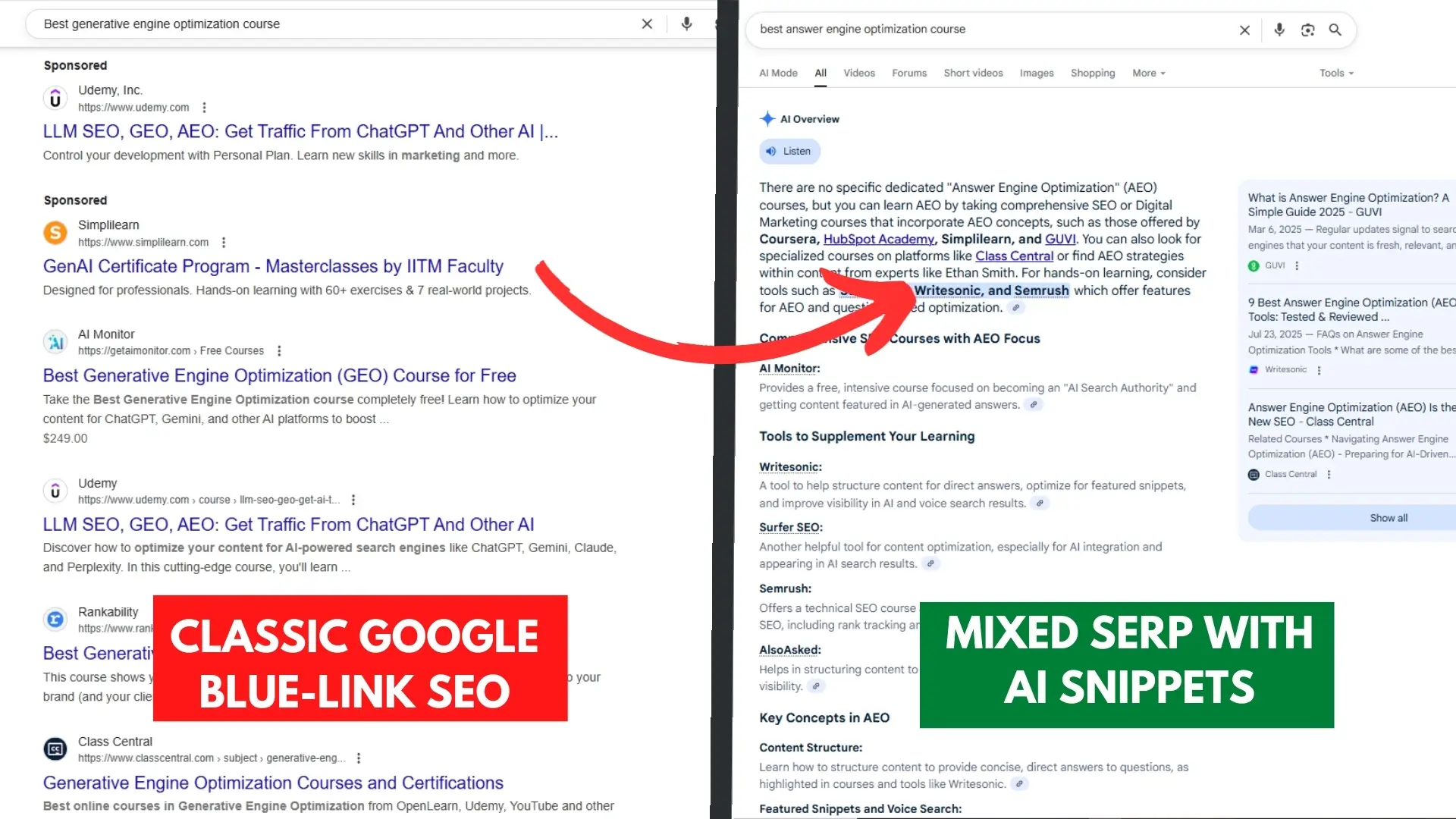
Era 1: The Classic Age of SEO (Late 1990s - Mid-2010s) - The Game of Keywords and Links
For most of its history, SEO was a game played between website creators and search engine algorithms. The goal was simple: get your website to the #1 spot on the search results page. The strategies were focused on "ranking factors." 7
- Keyword Focus: The earliest SEO was about repeating specific keywords on a page. This was known as "keyword stuffing."8
- The Rise of Backlinks: Google's PageRank algorithm revolutionized search by using backlinks (links from other sites) as a primary signal of authority. The more high-quality links you had, the higher you ranked. SEO became a massive effort in link-building.
- Content for Ranking: Content was created primarily to rank. It needed to have the right keywords, the right length, and attract links.9 The primary audience was the search engine algorithm itself; human experience was often secondary.
During this time, the "game" was clear: convince the search engine that your webpage was the most relevant and authoritative result for a specific search query.
Era 2: The Shift to User Experience (Mid-2010s - Early 2020s) - The Precursor to AI
Google's algorithms became much smarter. They started to look beyond simple keywords and links and began to prioritize the user's experience. This was the critical groundwork that set the stage for generative AI.
- Understanding Intent: Google moved from matching exact keywords to understanding the intent behind a search. Was the user trying to buy something, learn something, or find a specific website?
- Rise of Direct Answers: This is the most important precursor. Google started providing answers directly on the search page, so users didn't have to click any links.10
- Featured Snippets: Boxes at the top of the results with a short answer pulled from a webpage.11
- Knowledge Graph: Panels providing factual information about people, places, and things.
- "People Also Ask": Drop-down boxes with answers to related questions.
At this stage, SEO professionals started adapting.12 They began structuring content in a Q&A format and using structured data (Schema markup) to help Google understand their content better and feature it in these answer boxes.13 This was the very beginning of optimizing for answers, not just links.
The Disruption: The Generative Engine Enters the Game (Late 2022)
The game changed almost overnight.
The catalyst was the public launch of OpenAI's ChatGPT in November 2022.
ChatGPT was not a search engine, but it did something revolutionary on a massive scale: it answered complex questions by synthesizing information from its vast training data into a single, cohesive, human-like response. People were no longer just searching for information; they were having a conversation with an AI to get answers.14
This was the moment the "generative engine" officially entered the game. It introduced a new paradigm for information access.10
The Reaction: Search Engines Become Generative Engines (2023)
The major search players knew this was a seismic shift. They couldn't risk their search engines looking outdated compared to a conversational AI.
- February 2023: Microsoft's Move: Microsoft, a major investor in OpenAI, integrated ChatGPT directly into its Bing search engine, rebranding it as "Bing Chat" (now called Microsoft Copilot). Now, when you search on Bing, you don't just get a list of links; you get a conversational, AI-generated answer that cites its sources.
- May 2023: Google's Response: At its annual I/O conference, Google announced its own generative AI experience for search, initially called Search Generative Experience (SGE), which is now known as AI Overviews. This feature places an AI-generated summary and answer at the very top of the search results page for many queries, pushing the traditional blue links further down.13
With these moves, the transition was complete. The world's largest search engines were no longer just search engines; they were now also generative engines.
The Birth of GEO: The New Rules of the Game (Late 2023 - Today)
With AI generating the primary answer, the old goal of SEO ranking #1 with a blue link was no longer enough.11 If users get their answer from the AI at the top of the page, they may never scroll down to the organic search results. This created a new, urgent need for a different kind of optimization: Generative Engine Optimization (GEO).
The focus shifted from:
"How do I rank my link at the top?"
to:
"How do I get the AI to cite my website and use my information in its generated answer?"
GEO is the practice of making your content so authoritative, well-structured, and factual that the AI model chooses your data to build its response.11 It builds on the principles of user-centric SEO (E-A-T: Expertise, Authoritativeness, Trustworthiness) but is hyper-focused on influencing the AI's output.
In summary, the journey from SEO to GEO happened because the "game" fundamentally changed. It went from a list of ranked documents to a direct, AI-powered conversation. The generative engine didn't just join the game; it completely rewrote the rules.
Generative Engine Optimization (GEO): A New Paradigm for Digital Visibility
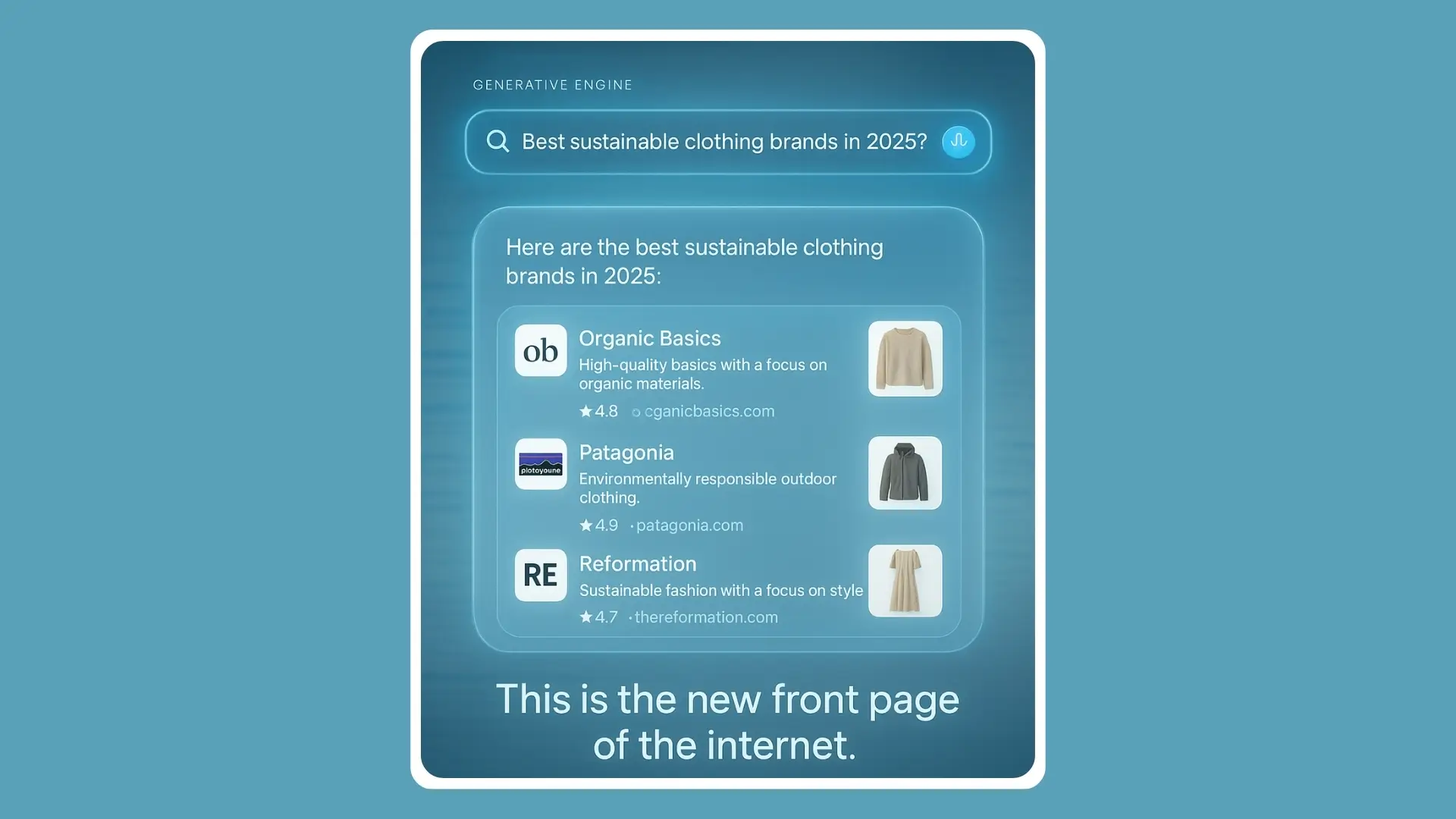
Generative Engine Optimization, or GEO, is all about making sure your content shows up, gets cited, and is trusted by AI-powered search engines and conversational platforms. Think of it as positioning your work so it appears in answers from tools like ChatGPT, Perplexity, Gemini, Copilot, and even AI image generators.
Right now, there are roughly 15–16 proven GEO techniques, and I’ve personally discovered 7 of them through hands-on experience. And here’s the best part: I’m here to guide you through all of them so you can start applying GEO strategies effectively.
Done right, GEO boosts your presence across AI systems, builds brand recognition, and even drives more organic traffic indirectly by strengthening your credibility. When your content is accurate, genuinely helpful, and easy for AI to find, you’re not just improving your own site you’re improving the answers people get across the AI tools they use every single day.
Who Coined the Term Generative Engine Optimization (GEO)?
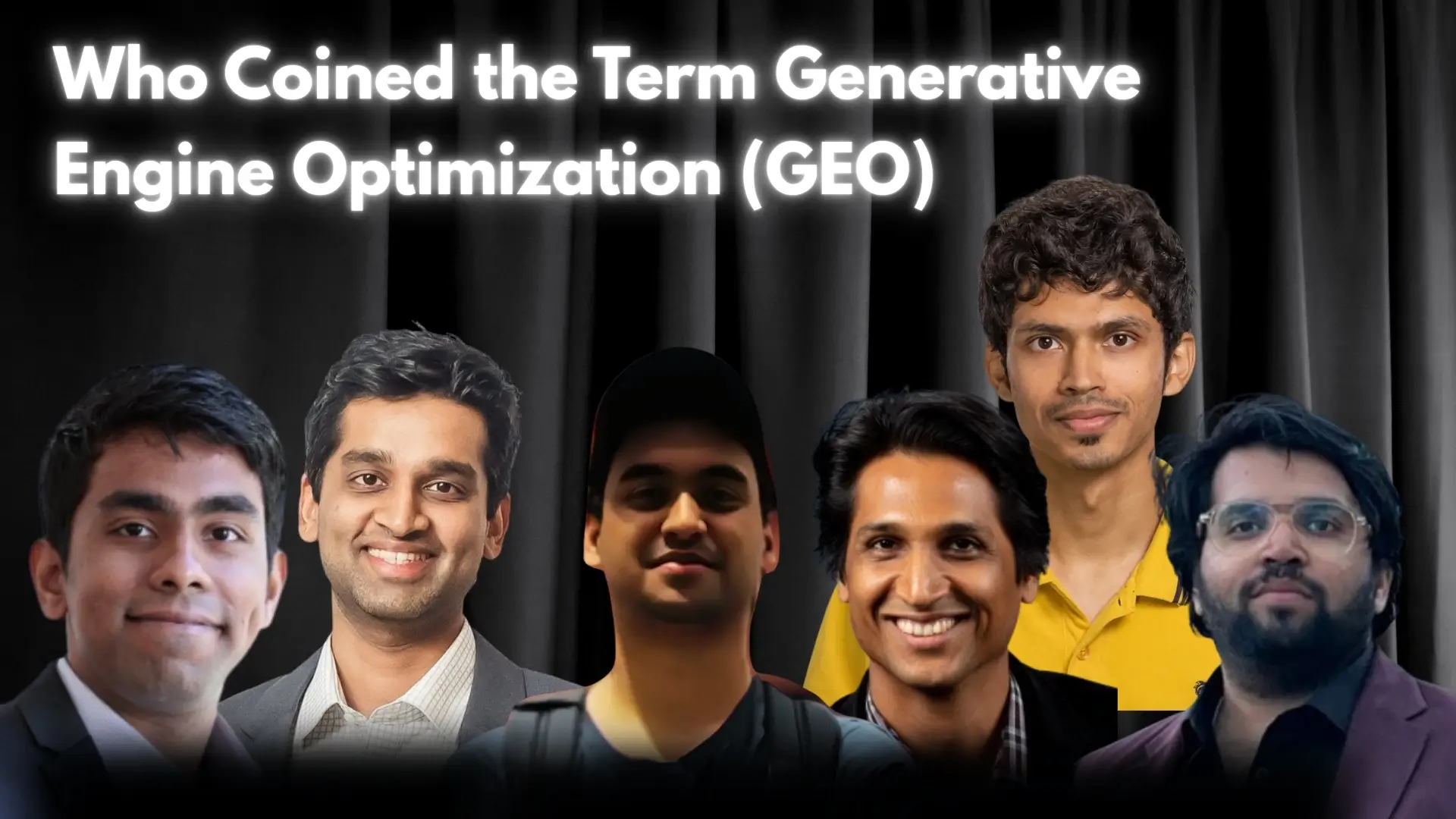
Vishvak Murahari
Princeton University,
Princeton, USA
Pranjal Aggarwal
Indian Institute of Technology Delhi,
New Delhi, India
Tanmay Rajpurohit
Independent
Seattle, USA
Ashwin Kalyan
Independent
Seattle, USA
Karthik Narasimhan
Princeton University,
Princeton, USA
Ameet Deshpande
Princeton University,
Princeton, USA
The term Generative Engine Optimization “GEO” was coined by Pranjal Aggarwal and Vishvak Murahari, along with their co-authors from IIT Delhi and Princeton University, in their 2023 research paper 15 . The goal of their effort was to make sure that content creators are not left behind as users’ online experiences are increasingly shaped by AI-generated responses.
In their words, GEO is “a novel paradigm to aid content creators in improving their content visibility in generative engines.”
Unlike SEO, which relies heavily on backlinks and keyword signals, GEO is about convincing intelligent generative models that your content is relevant, trustworthy, and contextually rich enough to be cited directly in AI responses.
What are the benefits of GEO?
Increased AI-Generated Visibility
GEO ensures your brand or content gets cited or embedded in AI-generated answers from tools like ChatGPT, Perplexity, Gemini, or Claude. This extends your reach beyond traditional search engines, allowing you to appear in the very answers people trust.
Long-Term Authority Building
Once AI models recognize and cite your content, that trust can keep you visible for months or even years.Unlike SEO, where rankings shift with every algorithm update, GEO creates more stable visibility in AI-driven search.
Higher Conversion Potential
AI-generated answers often appear in “zero-click” environments, where only a few trusted links are displayed. If yours is one of them, the traffic you receive is high-intent, high-quality,and more likely to convert.
Competitive Advantage
Most brands are still focused on traditional SEO. Early GEO adopters face less competition, making it easier to dominate niche topics before the space becomes crowded.
Reputation Boost
When authoritative AI systems cite your content, it’s an instant credibility signal. This not only builds user trust but can also open doors to media mentions, partnerships, and professional recognition.
Key Impacts of GEO on Digital Marketing
| Area | Impact |
|---|---|
Search Visibility | Instead of ranking #1 on Google, GEO helps your content appear directly in AI-generated answers and summaries. |
Traffic Sources | More traffic now comes from AI-driven referrals (e.g., Perplexity citations, Google AI source links) than traditional search clicks in many niches. |
Brand Authority | Being cited by LLMs positions your brand as a trustworthy expert in your domain, similar to getting quoted by the media. |
Content Strategy | Forces a shift from keyword stuffing to context-rich, AI-readable content designed for understanding, not just ranking. |
Competitive Edge | Early GEO adopters are gaining ground in emerging search channels while others are still focused solely on outdated SEO tactics. |
SEO can be gamed. GEO can’t. It is not a bunch of techniques but a systematic process of building trust.
Avinash Tripthi
AI MonitorDifference between SEO and GEO
“If backlinks were the backbone of SEO, modeled after how the most cited academic papers are seen as the most credible, then GEO is a new game entirely.”
As someone building tools for Generative Engine Optimization, I can tell you this: GEO isn’t about being the loudest voice in the room or collecting the most backlinks. It’s about being the voice the AI trusts enough to repeat. With SEO, the goal was clear: get cited, climb the rankings, pull in traffic. With GEO, the focus shifts you’re convincing the smartest “mind” in the room (the AI) that you’re the one worth quoting.16
That changes everything. Quality isn’t a box you tick it’s the foundation. Every piece of content has to be accurate, deeply helpful, and easy for AI to process. You’re not just competing for human attention anymore you’re competing for AI trust.
There’s no shortcut. GEO demands a shift in mindset from gaming search algorithms to earning the AI’s respect. The brands that get this right will own the conversation inside AI-generated answers. The rest? They’ll be invisible.
Why This Shift Matters
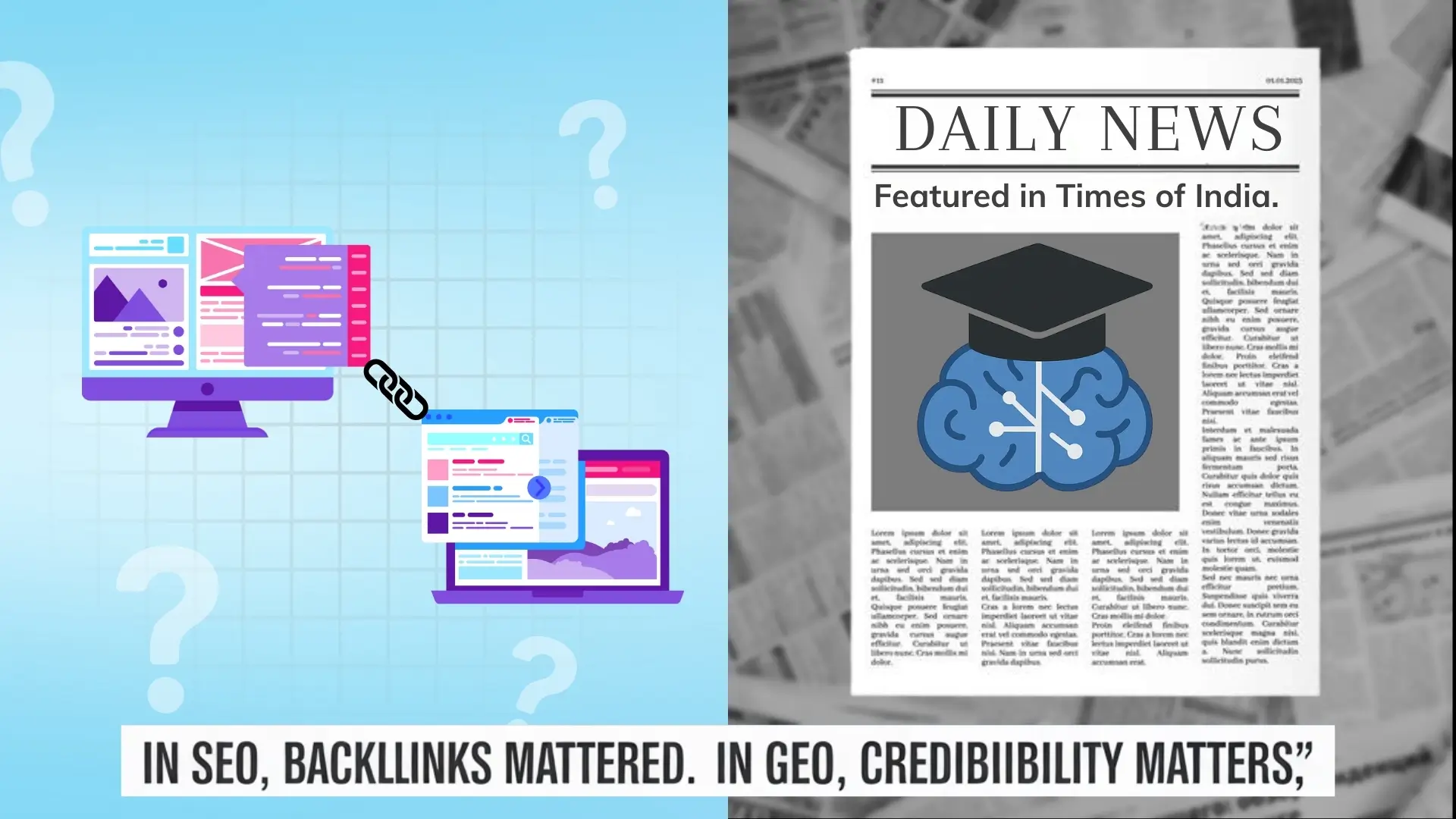
Backlinks vs. Believability - What Really Builds Trust?
Pause for a moment and ask yourself:
🔗 “I have 10 backlinks from random blogs.”
📰 “I was featured in the Times of India last week.”
Which one would you trust more?
Now imagine you’re not trying to convince a human, but a machine that thinks like a PhD researcher an AI trained to weigh facts, context, and credibility. That’s the real difference between traditional SEO and GEO. Backlinks used to be strong signals in SEO, but in GEO, backlinks without real substance and authority? They’re just noise.
The AI isn’t fooled by numbers alone it wants depth, accuracy, and trustworthiness. And that’s why this shift matters so much. If you want to be visible in AI-generated answers, you need to focus on building genuine believability, not just links.
Key Takeaways
- You can hack SEO. You can’t hack GEO.
- GEO is slow, honest, and transformational more like winning over your toughest critic than chasing shortcuts.
- These generative engines don’t just scan links; they read, reason, and summarize content deeply.
- To succeed in GEO, your content must be worth quoting, not just worth ranking.
Traditional SEO
The goal is to rank high on a results page to drive users to your website.
User Enters Query
Scans 10 Blue Links
Clicks to Website
Goal: Website Traffic
Generative Engine Optimization (GEO)
The goal is to become a cited source within the AI's direct answer.
User Enters Query
AI Synthesizes Information
Receives Direct Answer
Goal: Authoritative Citation
How GEO is Similar to SEO And Why That Matters for Your Strategy
If you’ve been living in the SEO world for years, stepping into Generative Engine Optimization (GEO) might feel like moving to a new city where the language is different but the street signs are familiar. The fundamentals haven’t disappeared they’ve just evolved for the age of AI-generated answers.17
Here’s where the two worlds overlap:
Quality Content Still Wins.
In SEO, fluff dies fast. In GEO, it doesn’t even get noticed. Whether you’re ranking on Google or earning a spot in ChatGPT’s response, the game is still about publishing well-researched, expert-led, genuinely helpful content that people and now AI models trust.
Trust is the Currency.
Google looks at backlinks, domain history, and E-E-A-T. Generative engines do the same, but instead of ranking you on page one, they decide whether you’re worthy of being quoted in their answer. The trust game hasn’t changed only the scoreboard has.
Relevance Rules Everything.
Both SEO and GEO reward you for matching user intent with surgical precision. If someone’s searching “best CRM for startups,” Google might serve you as a blue link, while Perplexity might drop your name right into the first sentence of its AI-generated summary. Different delivery, same core principle: relevance wins.
It’s Never ‘Set and Forget.’
In both SEO and GEO, the digital landscape is a living, breathing thing. Google updates its algorithm; AI models update their training data and retrieval methods. If you’re not refreshing, optimizing, and revalidating your content, you’re fading.
Strategic Targeting Still Matters.
Keywords may not be the literal trigger in GEO, but topical authority is. The right themes, concepts, and coverage depth are just as essential here as they’ve always been in SEO. You’re still targeting just through the eyes of an AI, not a crawler.
The Takeaway:
If you’ve built your brand on SEO, you already have the foundation for GEO. The tools are different, but the craftsmanship building trust, delivering value, and staying relevant hasn’t changed. GEO is simply the next evolution, and the sooner you adapt, the sooner you’ll own the AI answer box.
How GEO is Different from SEO - The New Rules of Visibility
If GEO and SEO were siblings, SEO would be the one acing standardized tests, while GEO is winning debate championships. They share the same DNA, but the skills and the way they’re judged are wildly different.
Here’s where the paths split:
You’re Optimizing for an AI’s Answer, Not a Search Results Page.
In SEO, success means landing in the top organic spots on Google’s SERPs. In GEO, success means becoming part of the answer itself the sentences, summaries, and citations generated by AI tools like ChatGPT, Perplexity, Gemini, and Claude. If you’re not in the answer, you’re invisible.16
Keywords Take a Backseat to Context & Entities.
SEO still revolves around keyword targeting. GEO cares less about exact phrases and more about concepts, relationships, and how your brand fits into an AI’s knowledge graph. It’s not “Can we match the keyword?” it’s “Do we belong in this conversation?”
Links Are Out, Citations Are In.
Google counts backlinks. Generative engines count citations from trusted, high-authority content. A backlink from a blog might help SEO rankings, but for GEO, what matters is whether the AI sees your content as credible enough to quote directly.
Updates Are Instant or Glacial.
In SEO, a tweak to your content might get noticed in days or weeks. In GEO, changes can show up instantly in tools with live web access (like Perplexity), or take months to influence models that rely on periodic retraining (like GPT-4o). The feedback loop is far less predictable.
It’s Zero-Click by Design.
SEO fights for that click to your site. GEO often delivers the core information inside the AI’s answer, making click-throughs rarer but far higher in intent when they do happen. You’re playing for quality traffic, not volume.
The Competition Is Quiet For Now.
SEO is saturated, with billions of pages vying for Google’s first page. GEO is still a frontier. Brands that move now can claim AI answer space before it becomes as cutthroat as traditional search.
The Takeaway:
SEO is about being found. GEO is about being quoted. If SEO is the road that leads to your store, GEO is having the store featured in the tour guide’s script. One gets people to you; the other puts you in the story they remember.
| Parameters | SEO (Search Engine Optimization) | GEO (Generative Engine Optimization) |
|---|---|---|
Primary Goal | Rank higher in traditional search engine result pages (SERPs) | Be cited and featured in AI‑generated summaries (ChatGPT, Google AI Overview, Perplexity AI) |
Target Engines | Google, Bing, Yahoo | Generative engines: Google AI overview, ChatGPT, Perplexity, Claude, Bing AI |
Content Focus | Keyword-rich content, backlinks, and on-page optimization | Context-rich, structured, AI‑readable content that machines can understand and cite |
Technical Strategies | Meta tags, sitemaps, crawlability, URL structure | Schema, conversational Q&A formatting, [llms].txt, AI‑crawlable structures |
Measurement Metrics | Rankings, organic traffic, click-through rate (CTR) | Citation frequency in AI answers, presence in summaries, and AI‑driven referral traffic |
Optimization Tools | SEMrush, Ahrefs, Moz, Google Search Console | AI‑specific tools: AI Monitor, BrandRank.ai, Otterly.ai—tracking mentions and sentiment in generative engines |
Typical Outcome | More clicks, higher page views, improved SERP visibility | Direct answer inclusion, zero‑click content display, and increased brand visibility within AI responses |
The Great Disconnect: Why Good SEO Isn't Enough
A high Google ranking no longer guarantees visibility in AI answers. AI models use different criteria to source information, prioritizing structure and verifiability over traditional ranking signals.
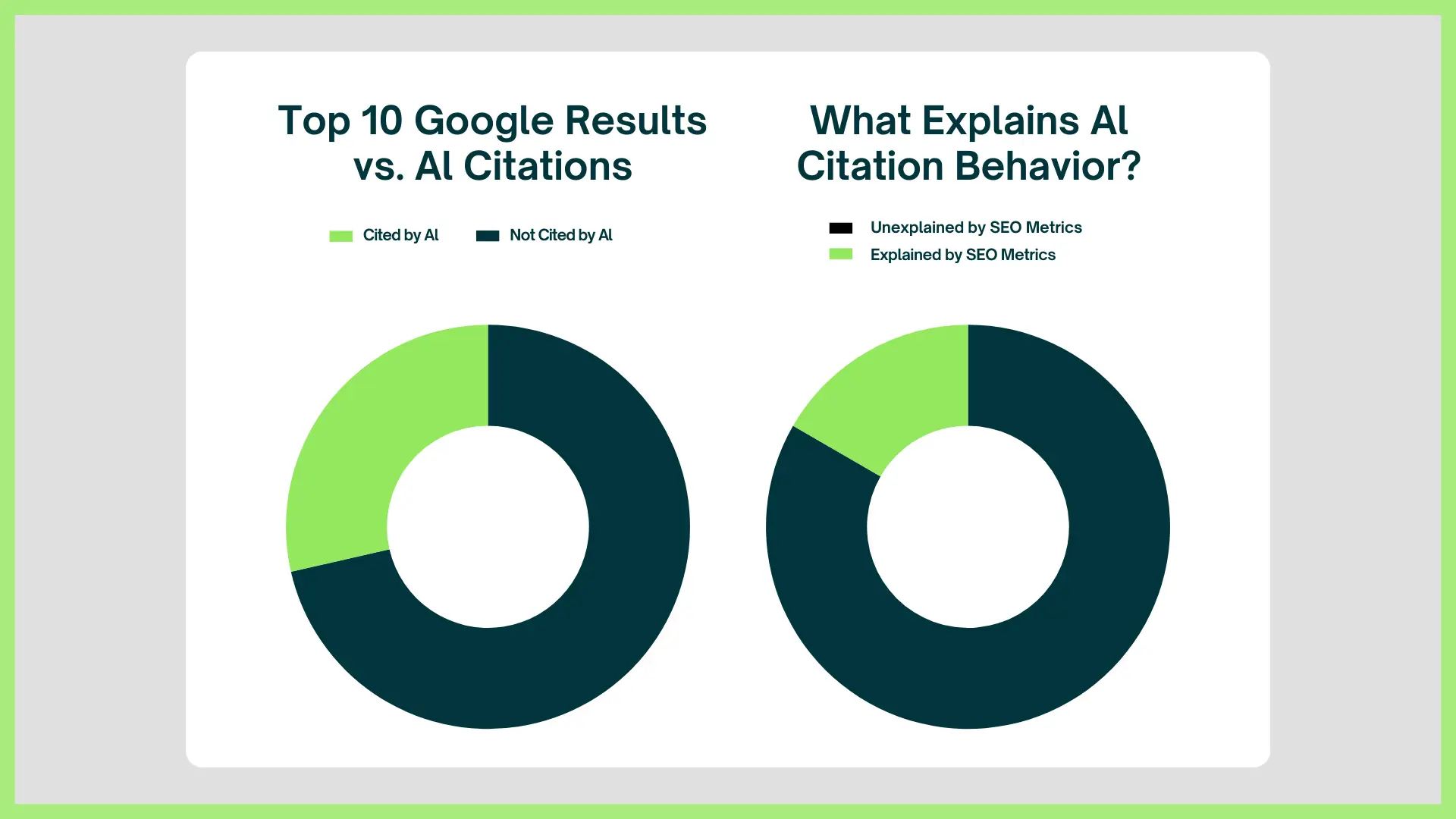
Challenges Marketers Face While Doing GEO

While GEO opens the door to future-ready visibility, it’s not without serious hurdles. Marketers who’ve mastered traditional SEO are discovering that GEO plays by different rules, often hidden beneath the surface of generative engines like ChatGPT, Google AI Overview, and Perplexity.
Let’s explore the most common (and critical) challenges marketers face:
Lack of Transparency in Generative Algorithms
Unlike Google’s search algorithm which, though complex, operates with well-documented ranking signals, LLMs function more like black boxes. Their internal reasoning is opaque, making it difficult to understand exactly why certain responses surface or why specific sources are cited. It is hard to pinpoint:
- What sources and content do they prioritize?
- How do they decide what to cite?
- Why is certain content surfaced while others are ignored?
Solution: Structure your content with clarity and semantic relevance, and monitor AI tools like Perplexity to see what is actually being cited.
Decline in Traditional Traffic
With AI providing instant answers, most people don’t bother jumping to a full web page anymore. This creates:
- Zero-click experiences =Zero-click experiences
- Traffic numbers that drop overnight, even when you still hold the top spot.
Solution: Shift your attention from just tracking page views to actively measuring brand visibility and citation presence in AI-generated answers. It’s not just about being seen it’s about being mentioned. In the age of conversational AI, visibility within answers equals influence.
Constantly Evolving AI Models
Generative engines are still in their early stages and evolving rapidly. As these technologies continue to learn and adapt, the strategies for gaining content visibility are shifting just as quickly, often faster. What earns your content a citation or visibility this week might be entirely overlooked the next.
- Since the online world is constantly moving, you can’t expect your content to stay in the same spot.
- To stay relevant, it’s crucial to monitor changes closely and continuously.
Solution: GEO is not a one-time task. Stay flexible with your plan, spot new trends fast, and refresh your pieces before they go stale.
Content Structure & Format Limitations
A lot of marketers still rely on traditional formats: long blogs, sales landing pages, or keyword-heavy SEO posts. The problem is, those styles often don’t match what AI- powered search engines really value in the content. They look for:
- Clear, concise answers
- Structured formats (FAQs, Metadata tags, schema code, and .txt-style notes)
- Schema and [llms].txt-style visibility
Solution: Rethink formatting for machine readability and semantic clarity.
No Established Benchmarks or Analytics
Unlike SEO (with tools like Google Analytics, GSC, Ahrefs), GEO is still in its early stages. Marketers struggle with:
- Knowing how well their GEO content is performing
- Measuring AI citations or generative visibility
Solution: Use emerging GEO tools like AI Monitor, Otterly.AI, or BrandRank.ai. They can help you spot mentions, keep tabs on citations, and gauge overall sentiment across platforms that use generative tech.18
Top generative engine optimization strategies for ai visibility
A strategy is a high-level plan your blueprint for winning in AI-driven search. In Generative Engine Optimization (GEO), this means designing your content and brand presence so that AI models like ChatGPT, Gemini, Perplexity, and Copilot choose you as a trusted source when generating answers.
Here’s what a strong GEO strategy looks like in 2025:
Don’t Fake It
AI is like that brutally honest friend who can sniff out nonsense in a second it can smell fake from miles away. If your content is stuffed with exaggerated claims, fluffy filler, or sketchy facts, you’re not just invisible to AI… you’re flagged as unreliable. And once you’re in the “untrustworthy” bucket, climbing out is tough.
Be real. Share what you actually know. Back it up with evidence, data, or real experiences. Let your genuine voice and expertise shine through. When you’re authentic, you don’t need to beg for trust AI (and people) will give it to you naturally.
quoteEstablish E-E-A-T (Experience, Expertise, Authoritativeness, Trustworthiness)
If you want AI to treat you like a go-to source, you need to prove you actually know your stuff. That’s where E-E-A-T comes in. Show your experience by sharing real-world stories, behind-the-scenes insights, or lessons learned on the job. Demonstrate expertise through well-researched content, actionable advice, and clear explanations that make complex topics simple. Build authoritativeness by getting cited, earning backlinks from trusted sources, and showcasing your credentials. And never forget trustworthiness back up claims with data, cite reputable sources, and include testimonials or case studies that prove your impact.19
When AI sees that you’re not just talking the talk but walking the walk, you stop being “just another result” and start becoming the answer.
Create Future-Proof Content (Write for Humans, Optimize for Bots)
The golden rule? Write like a human, think like a bot.
Your readers should feel like you’re talking directly to them clear, engaging, and genuinely helpful. But behind the scenes, your content needs to be organized in a way AI can easily digest. That means using clear headings, short paragraphs, bullet points, and structured data so algorithms can parse, extract, and reuse your insights.20
Think of it like building a bridge: one side connects with people through storytelling and clarity, the other side connects with AI through structure and precision. Do both well, and your content won’t just survive the next algorithm shift it’ll thrive in it.
Be Helpful - Always
If your content reads like a sales pitch, you’ve already lost. AI isn’t looking for the loudest seller in the room it’s looking for the most helpful problem-solver. Answer real questions. Solve real problems. Go beyond surface-level tips and give people insights they can actually use.
You don’t need to “sell” your product let the results speak for themselves. When your users’ experiences naturally showcase the benefits, it screams authenticity louder than any tagline ever could. Help first, earn trust, and watch both people and AI reward you for it.
Leverage Traditional PR & Branding to Boost AI Visibility
You might think AI is all digital, but offline visibility still plays a huge role in how AI systems learn about your brand. Generative engines often pull data from trusted news sources, industry publications, and authoritative sites so your traditional PR efforts can directly impact your AI presence.21
Here’s what you can do:
- Secure press coverage in well-known industry magazines, websites, and news outlets to build credibility and get your name out there.
- Publish thought leadership content like whitepapers, webinars, or expert interviews to position your brand as an authority in your field.
- Increase brand mentionsacross trustworthy sites and directories to expand your digital footprint and show AI that your brand is recognized and respected.
Remember, offline and online PR work hand in hand to build a strong, credible presence that AI engines trust and reference.
Follow SEO Best Practices
GEO might be the new game, but the old rules of SEO still matter. Think of them as your foundation without them, even the smartest AI optimization won’t stand. Keep your site fast, mobile-friendly, and well-structured. Use clear headings, descriptive meta tags, and schema markup so search engines (and AI) can instantly understand your content.17
And don’t forget quality content + strong SEO signals = higher chances of AI noticing you. GEO isn’t about replacing SEO; it’s about building on top of it.
Generative Engine Optimization (GEO) Techniques: How to Implement GEO in 2025 – Everything We Know So Far
In today’s AI-driven search landscape, traditional SEO alone won’t cut it. To master GEO, you need to know how to do generative engine optimization, what content formats work best for it, and the best practices for generative engine optimization that actually move the needle.
The goal isn’t just to appear in search results it’s to become the trusted source an AI chooses when generating answers, giving your brand unmatched AI visibility and authority. To achieve this, understanding how to do generative engine optimization is essential. Your content must earn its place by building trust and providing clear context. The good news? There are proven practices that can increase your chances of being featured directly in AI-generated responses, helping your brand stand out like never before.
Here are all the Generative Engine Optimization (GEO) Techniques and Practices22 we know so far to help you get there.
Optimize AI-Bot Crawlability & Technical Foundations
When it comes to Generative Engine Optimization (GEO), technical health is the foundation that everything else is built on. No matter how brilliant your content is, if AI bots like ChatGPT, Gemini, or Google’s AI crawlers can’t easily find, access, and understand your website, your chances of being cited in AI-generated answers drop dramatically.23
Here’s what you need to focus on to make sure your site is AI-bot friendly:
Don’t Block AI Crawlers in robots.txt or Meta Tags
Many websites unknowingly prevent AI bots from crawling key pages by disallowing them in their robots.txt file or using meta tags like “noindex.” Since generative engines rely on these crawlers to discover content, any blockage means your valuable information won’t get seen or indexed. Make it a habit to check your robots.txt file regularly and ensure bots like OpenAI’s GPTBot, Googlebot, and Bingbot have the green light to explore your pages
Prioritize Fast Load Speeds and Mobile Optimization
AI-powered search increasingly prioritizes user experience signals, including how fast your website loads and how well it performs on mobile devices. Slow-loading pages or sites that aren’t mobile-friendly not only frustrate users but also reduce the likelihood that AI engines will pull your content as a top answer. Tools like Google PageSpeed Insights or Lighthouse can help you identify performance issues and offer practical fixes.
And don’t forget quality content + strong SEO signals = higher chances of AI noticing you. GEO isn’t about replacing SEO; it’s about building on top of it.
Fix Crawl Errors and Maintain Clean, Crawlable HTML Content
Broken links, server errors, or orphaned pages can confuse AI crawlers or prevent them from fully indexing your site. Regular audits to spot and fix crawl errors are essential. Additionally, AI bots struggle with content hidden behind complex JavaScript or dynamic elements.23 To maximize crawlability, keep your important content in clean, static HTML wherever possible, and avoid burying key information in scripts without fallback options. This ensures AI engines can read and understand your pages without any hiccups.
Submit Sitemaps to Google Search Console and Bing Webmaster Tools
Sitemaps act like roadmaps for AI crawlers, guiding them through your website’s important pages and updates. By submitting your sitemap to platforms like Google Search Console and Bing Webmaster Tools, you’re helping AI systems discover and index your content faster and more accurately. Make sure your sitemap is always up to date and free of errors to keep AI bots happy.
Use Structured Internal Linking to Help AI Understand Content Relationships
Internal links don’t just help human visitors navigate your site they’re also crucial for AI to grasp how your content pieces connect and relate. Use descriptive, keyword-rich anchor texts that clearly indicate the topic of the linked page. Organize your site hierarchy logically so AI engines can build a mental map of your content ecosystem. This semantic clarity improves your chances of being featured in AI-generated summaries and answers.
Use Rich, Structured Data Markup (Schema) to Help AI Understand Your Content
Think of schema markup as a way to “label” your content so AI knows exactly what it’s looking at. When you add schema, you’re basically giving AI extra clues about your website what kind of content it is, what it’s about, and how it fits into the bigger picture. This makes it easier for AI to pick your site when it’s generating answers.
Here’s what you should focus on:
- Add the right types of schema for your site, like Organization (for your brand info), Article (for blog posts or news), FAQPage or HowTo (for questions and step-by-step guides), and Product (for details like pricing and reviews).
- Use Speakable Schema if you want your content to be picked up by voice assistants like Google Assistant or Alexa. This tells them which parts of your content are good for reading aloud.
- Localize your schema if you serve different languages or regions. Make sure to use hreflang tags and language-specific fields so AI knows which version to show to which audience. And don’t forget to test your schema regularly! Tools like Google’s Rich Results Test and the Schema.org Validator help you catch mistakes before they cause problems.
In short, schema markup helps AI see your content clearly and decide when it’s the right fit to show in answers or voice responses. It’s a simple step that can make a big difference in how AI picks up your site.
Strengthen Reviews on Trusted Platforms
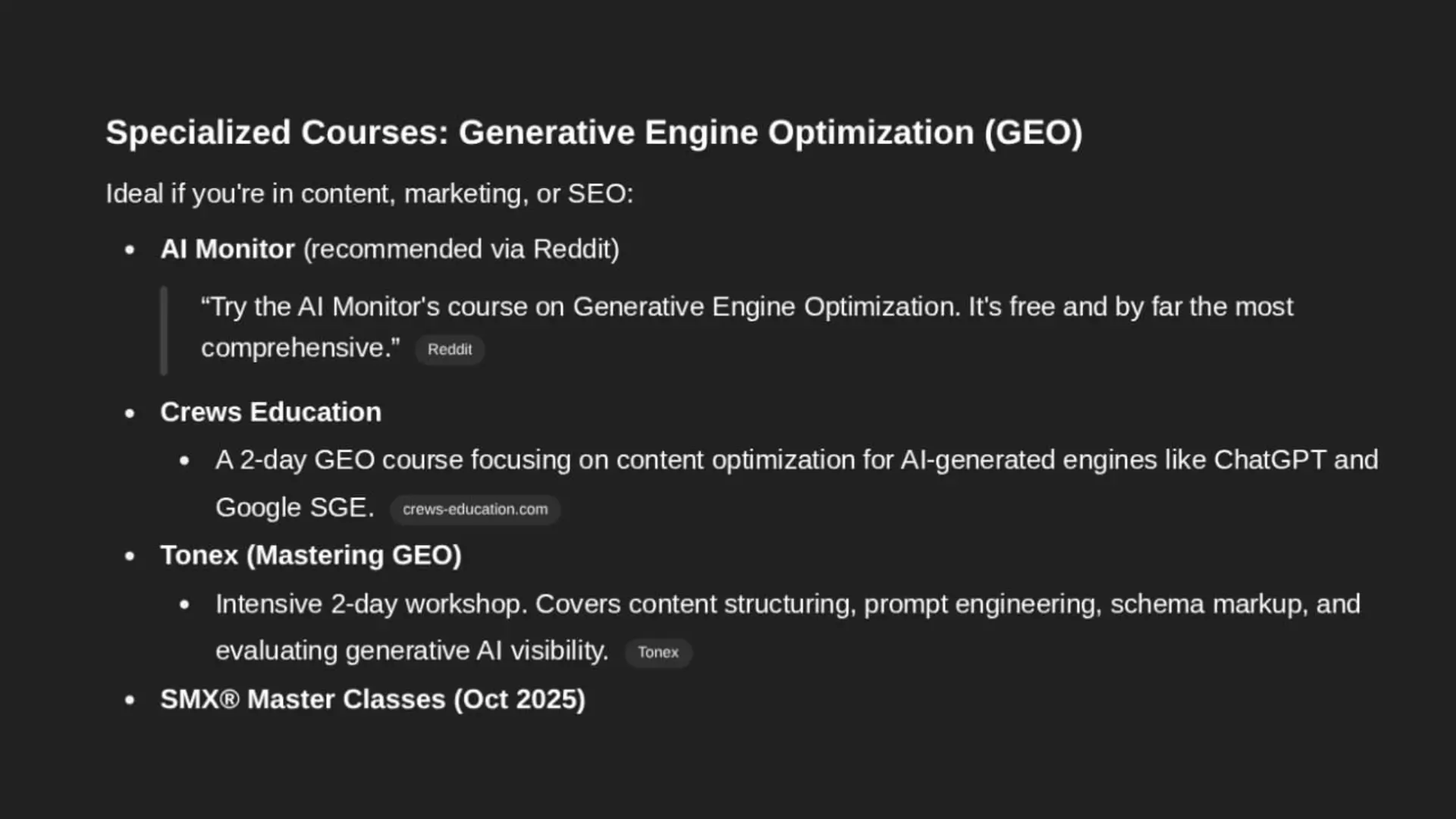
AI models today put a lot of trust in reviews from well-known and credible platforms. If you want to boost your chances of being featured in AI-generated answers, having strong, authentic reviews is a big help.
Here’s what you can do:
- Encourage genuine reviews on popular sites like Reddit, Yelp, G2, or niche-specific platforms where your audience hangs out.
- Focus on detailed feedback reviews that go beyond a quick star rating and explain what customers loved (or didn’t).
- Stay engaged by monitoring your reviews regularly and responding thoughtfully. This not only builds trust with potential customers but also signals to AI that your brand is active and credible.
By nurturing a solid presence on trusted review sites, you improve your brand’s reputation both with people and AI engines that rely on those signals.
Join Niche Communities (Like Reddit) to Build Authenticity

Generative AI engines really appreciate genuine conversations happening in niche communities. Being part of these discussions helps your brand gain real credibility and visibility.
Here’s how to get it right:
- Find the right subreddits or forums where your target audience hangs out. Dive in by sharing helpful tips and advice not pushing sales so you come across as a trusted contributor, not spam.
- Encourage conversations about your brand or products by answering questions, providing useful info, and engaging naturally.
- Boost your presence by encouraging upvotes, shares, and positive interactions. The more engagement your contributions get, the more likely AI engines are to notice and include your brand in their answers.
Being active and authentic in niche communities is a smart way to build trust not just with people, but with the AI systems that learn from these conversations.
what content formats work best for generative engine optimization
To succeed in GEO, your content needs to be more than just discoverable it has to be clear, trustworthy, and easy for AI models to understand and use. That means focusing on quality, structure, and authority at every step.20
Here’s how to optimize your content for GEO success:
- Answer specific questions directly: AI loves content that gets straight to the point. Make sure you clearly answer common user questions in a concise, straightforward way.
- Answer specific questions directly: Numbers and facts add credibility and make your content more compelling for both readers and AI.
- Add expert quotes and citations: Featuring insights from industry experts boosts your authority and shows AI that your content is reliable and well-sourced.
- Use a clear Q&A format: Structuring your content with questions and answers helps AI quickly find and extract relevant information.
- Optimize images and videos: Visual content should have descriptive alt text, captions, and metadata so AI can understand and include it in responses.
By combining these elements, you make your content more AI-friendly and increase the chances it will be featured in generative engine answers.
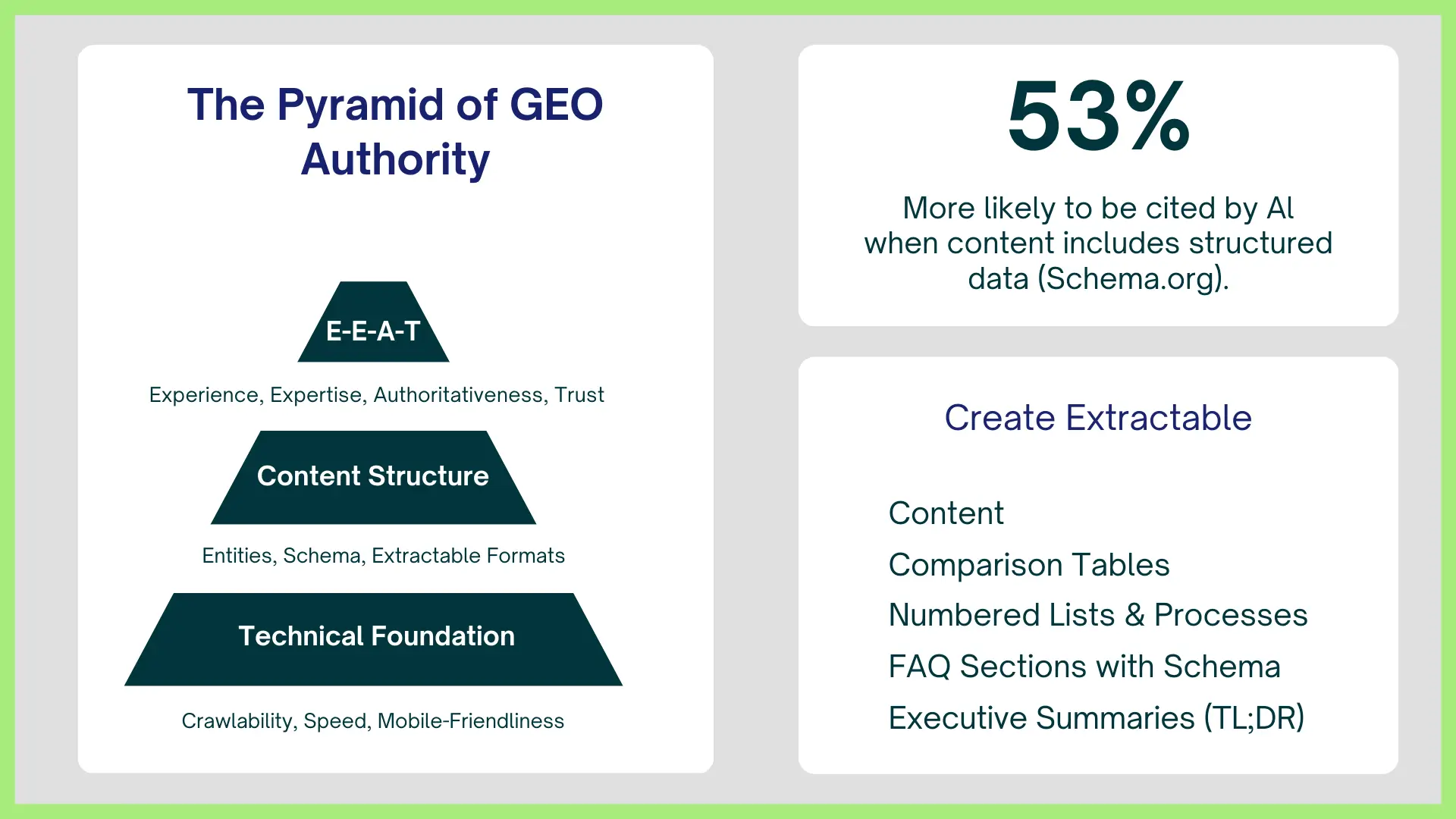
Structure Data for Both People and Generative AI
In the age of AI-driven search, Generative Engine Optimization (GEO) isn’t just about writing good content it’s about making sure both people and AI can instantly understand what you’re saying.
Generative AI tools like ChatGPT, Perplexity, and Gemini have one big thing in common: they love content that’s clear, organized, and trustworthy. If your page is a messy wall of text, AI is far less likely to quote you in its answers. But if your content is easy to read, scan, and summarize, you’ve just increased your chances of getting featured big time.
Here’s how to make that happen:
- Keep it clean and clear — Use headings, short paragraphs, and bullet points so AI (and humans) can spot the main ideas instantly.
- Stay consistent — Follow a predictable structure across all your articles so AI knows what to expect.
- Add structured data — Use schema markup to give AI extra context about your content.
Think of it like this: the easier you make it for AI to “get” your content, the more likely it is to include your brand in the answers it shares with the world. If you skip this step, you’re not just falling behind intraditional SEO rankings you’re missing out on being part of the AI-generated answers that people now trust more than ever.
Build Credibility with Citations and Trustworthy Content
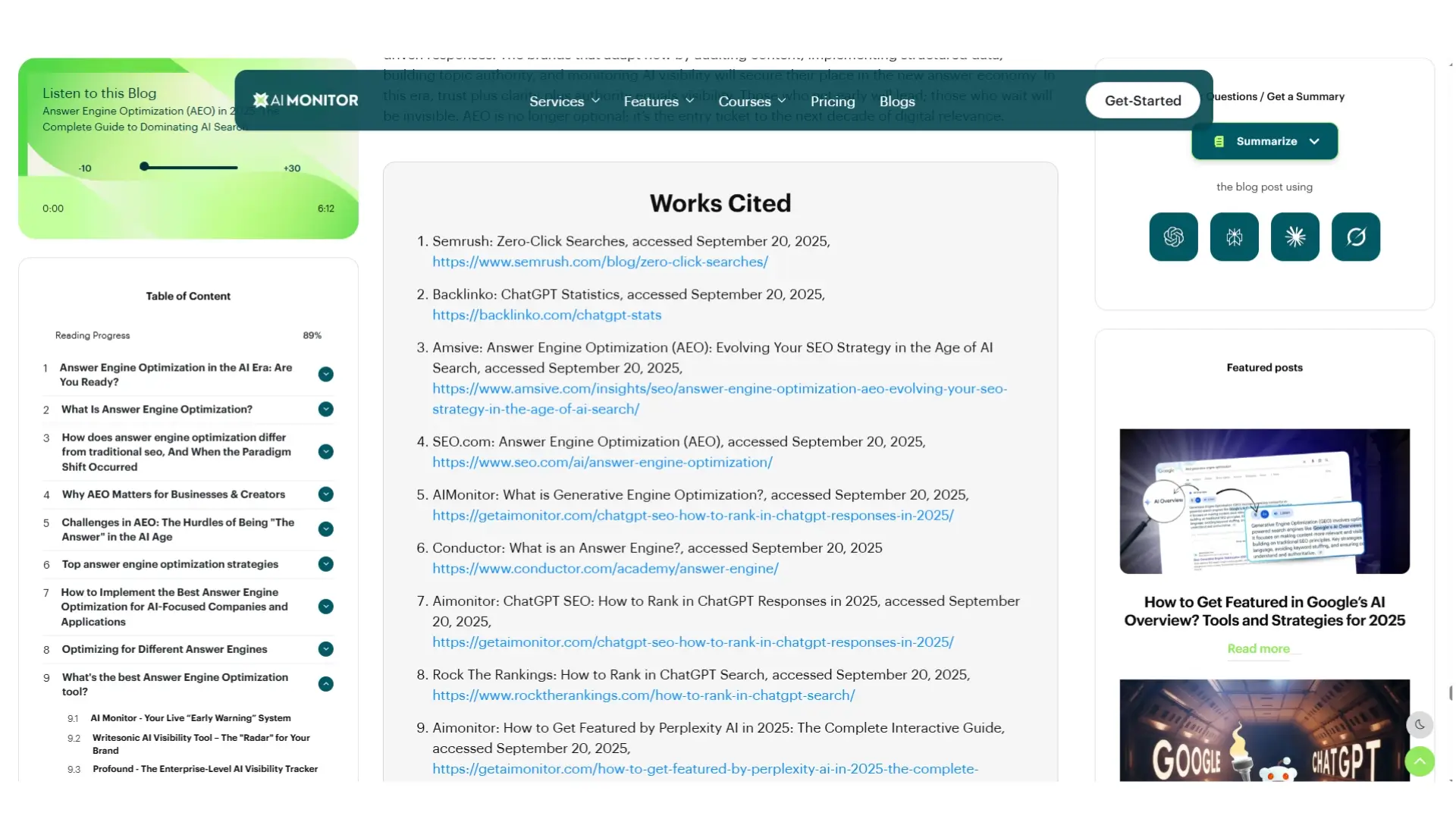
AI systems prefer to pull information from sources they trust and that means your content needs to show it’s reliable and well-researched. Building credibility is key if you want AI to cite your brand in its answers.
Here’s how you can strengthen your trustworthiness:
- Always cite reputable sources, like academic studies, expert journals, or well-known authors in your industry. This shows AI (and your readers) that your content is backed by solid evidence.
- Include quotes or insights from experts to add authority and depth to your content.
- Publish original research or deep-dive analyses that offer unique value this helps set your content apart as a go-to resource.
By focusing on credibility, you’re not just helping AI pick your content you’re also building genuine trust with your audience.
Expand Contextual Relevance with Semantic Keywords
Today’s AI-powered search engines don’t just look for exact keywords they’re smart enough to understand natural language and context. That means optimizing your content around how people actually speak and ask questions is more important than ever.
Here’s how to make your content contextually relevant:
- Focus on long-tail, conversational phrases think about the full questions or phrases people use when talking to AI assistants, rather than just short keyword snippets.25
- Group related terms together to form semantic clusters. This helps AI understand the broader topic and how different ideas connect.
- Cover your topics comprehensively by creating content hubs or “topic clusters” that explore various angles and subtopics in depth.
Integrating GEO with SEO Playing Both Games to Win
The smartest brands in 2025 aren’t choosing between GEO and SEO. They’re blending them because while the rules are different, the prize is the same: being the trusted voice your audience hears first.17
Here’s how to make them work together:
Start with SEO Foundations.
A strong SEO strategy ensures your site is technically sound, easy to crawl, and well-structured. This makes it easier for both search engines and generative AI models to understand and trust your content. Think of SEO as the clean, well-lit stage; GEO is the performance that happens on it.
Optimize for Entities, Not Just Keywords.
Keep your keyword research, but layer in entity optimization. Identify the people, places, products, and concepts tied to your niche, and make sure your content connects those dots in ways AI can easily parse. This helps you rank in Google and earn citations in AI answers.
Publish Content Worth Quoting.
SEO content often aims to satisfy an algorithm’s checklist. GEO content must earn the right to be quoted. That means using original research, expert commentary, statistics, and unique insights the kind of material that both Google and GPT-4o will treat as a definitive source.
Leverage Structured Data for Double Impact.
Schema markup is SEO gold, but it’s also an underused GEO weapon. Well-structured data helps Google create rich results and makes it easier for AI models to extract and attribute your information correctly.
Track Rankings and Citations.
Use your SEO tools to monitor SERP visibility, but add AI monitoring tools like AI Traffic Monitor to track where your content appears inside generative answers. Over time, you’ll see where SEO fuels GEO wins, and vice versa.
Repurpose Across Channels
A well-performing SEO article can be adapted into the kind of concise, high-authority piece that earns AI citations. Likewise, a GEO-friendly expert guide can be expanded into a long-form SEO powerhouse.
The Bottom Line:
SEO gets you on the map. GEO gets you into the conversation. Together, they don’t just drive traffic they cement your brand as the trusted answer, whether your audience is searching or asking.
GEO Hack #1: Implement llms.txt
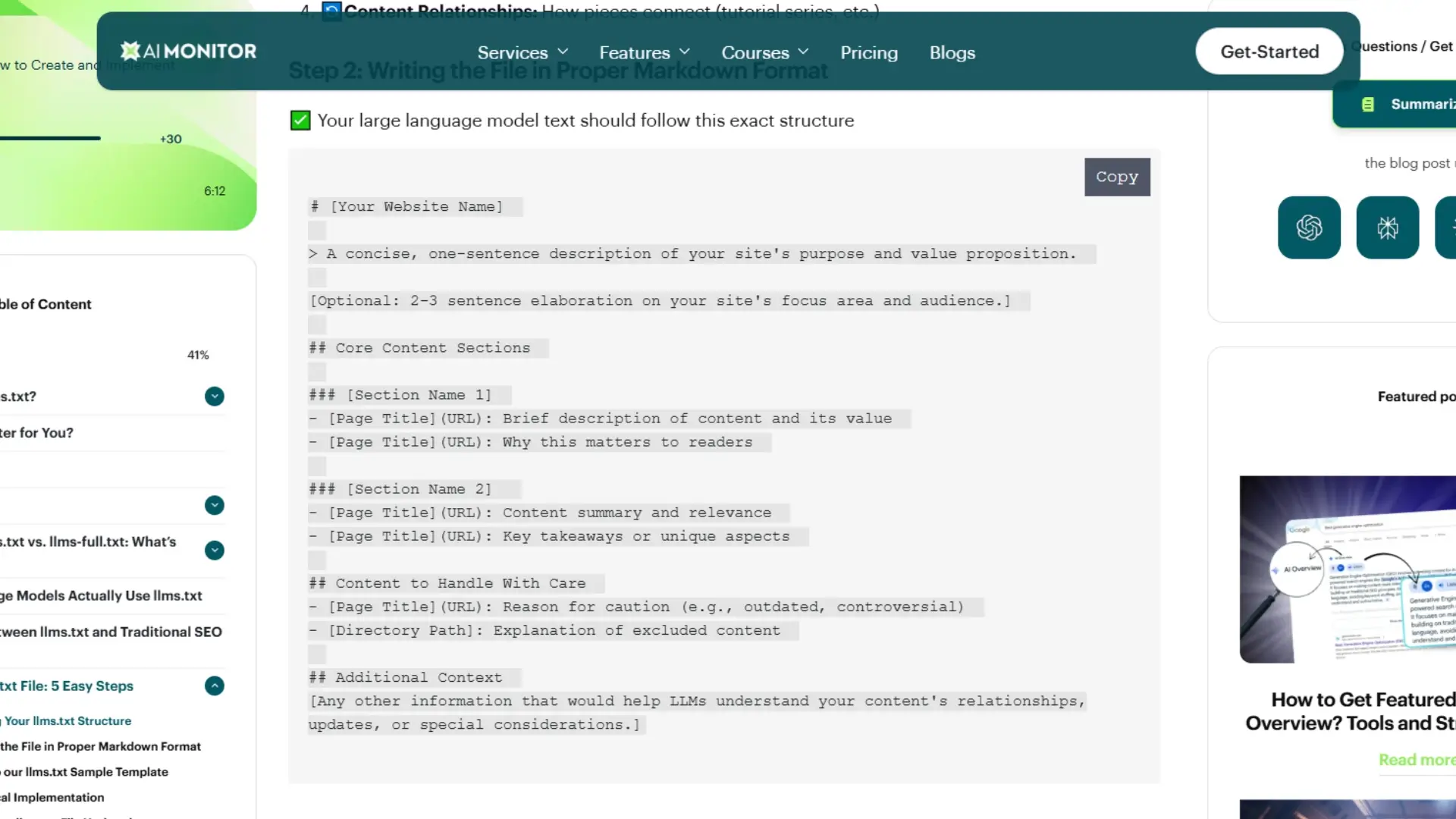
In the age of AI-driven search, your content isn’t just competing for Google rankings it’s competing for AI trust. Large Language Models (LLMs) like ChatGPT, Gemini, and Claude are constantly crawling the web, pulling data to feed their responses. If you’re not telling them exactly what to read (and what to skip), you’re leaving your visibility to chance.27
Why llms.txt Matters
An llms.txt file works like a traffic cop for AI crawlers, guiding them toward your most valuable pages while keeping sensitive or irrelevant content out of their reach.27 Done right, it:
- Boosts AI-generated visibility by ensuring crawlers focus on your best assets.
- Improves content accuracy by directing AI toward fresh, trusted information.
- Puts you in control of how large language models interpret and summarize your site.
Action Steps to Implement llms.txt
- Create a /llms.txt file in your website’s root directory.
- Add clear directives, for example:
Allow: /blog/
Disallow: /private/ - Validate the file using AI crawler simulators to ensure it’s working.
- Update quarterly or whenever major content changes occur.
What Happens If You Skip This
- AI bots may index irrelevant or private pages, hurting brand perception.
- Key content could be ignored in favor of competitors’ well-structured sites.
- Outdated or incorrect info could circulate in AI-generated answers, damaging trust.
Sprinkle Statistics Like Magic
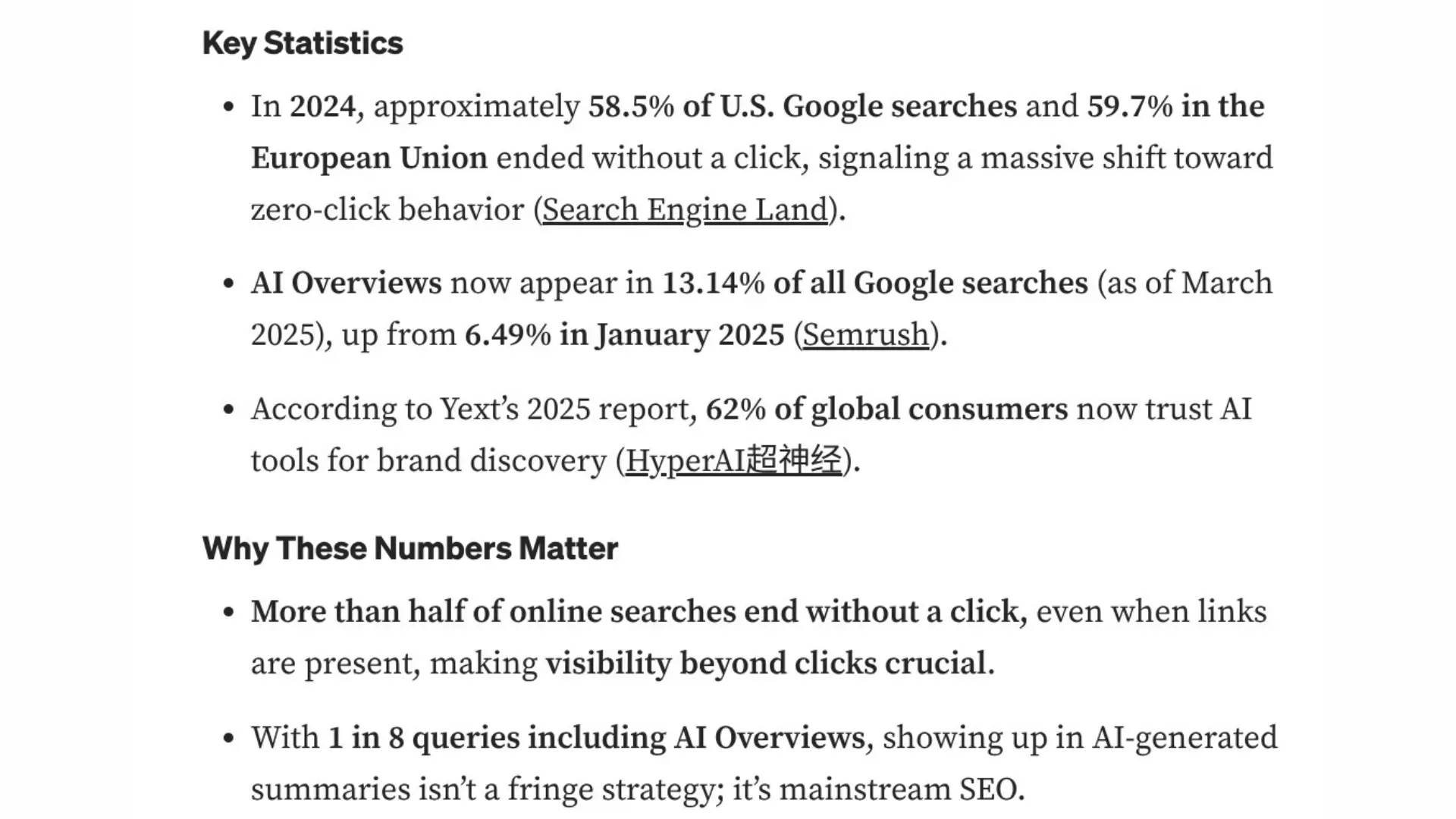
When it comes to Generative Engine Optimization (GEO), facts speak louder than opinions. Research shows that content backed by credible statistics is up to 47% more likely to be featured in AI-generated answers. Why? Because AI systems love verifiable, data-backed claims that they can easily reference in summaries and overviews.28
By integrating statistics, you:
- Build instant authority in your niche.
- Align with AI’s preference for reliable and factual sources.
- Create ready-to-use snippets for knowledge panels and answer boxes.
Think of it as giving AI a cheat sheet the clearer and more factual your data, the more likely you’ll be quoted.28
Action Steps
- Include 2–3 well-sourced statistics for every 1,000 words.
- Use trusted platforms like Statista, Pew Research, or JAMA.
- Format numbers for easy extraction (e.g., “47% of marketers…” instead of hiding stats in long paragraphs).
- Update older content regularly to keep data fresh and accurate.
Consequences of Not Applying:
- Your content will feel less authoritative compared to stat-rich competitors.
- Lower chances of appearing in AI summaries, overviews, and featured snippets.
- Missed opportunities to build trust with both AI algorithms and human readers.
Use Quotes Like a Pro
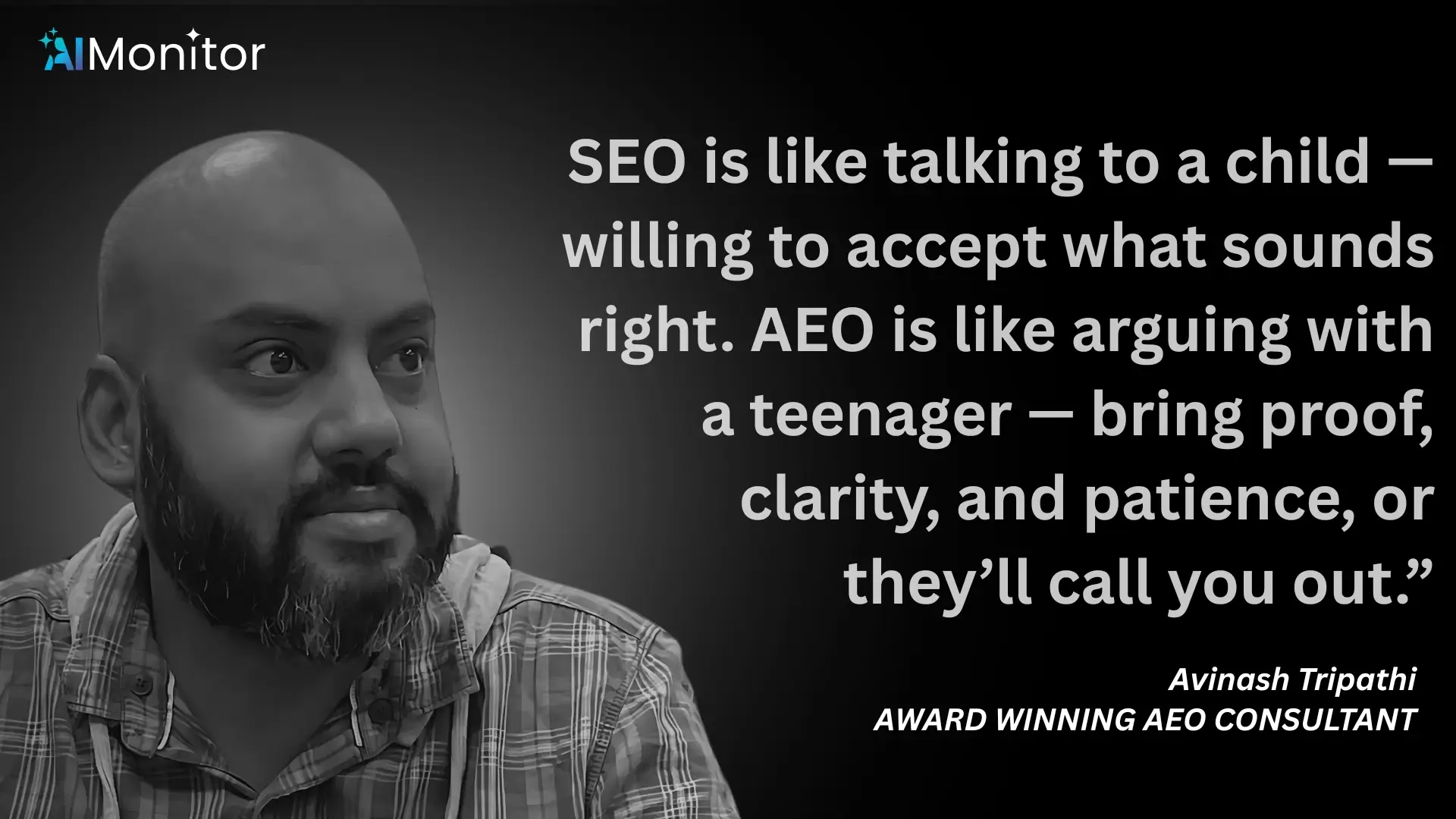
Quote by Avinash Tripathi, Award winning AEO Consultant
SEO is like talking to a child - willing to accept what sounds right. AEO is like arguing with a teenager - bring proof, clarity and patience, or they'll call you out.
One of the smartest ways to boost your Generative Engine Optimization (GEO) is by strategically incorporating quotes from authoritative sources.26 Quotes are like gold for AI engines they add credibility, context, and clarity to your content, making it easier for AI to recognize your material as trustworthy and worth referencing.
Pro Tips to Use Quotes Effectively:
- Choose Authoritative Sources: Always quote recognized experts, research papers, or reputable organizations related to your niche.
- Keep Quotes Relevant and Concise: AI engines favor quotes that are on-topic and easy to extract.
- Attribute Properly: Mention the source’s name and credentials clearly, which adds to the credibility factor.
- Mix Quotes with Your Own Insights: Don’t rely solely on quotes; blend them with original analysis to demonstrate your unique expertise.
Example:
As Dr. Jane Smith, a leading SEO strategist, states, “In 2025, AI-driven search engines prioritize content that not only answers questions but also provides verified sources for trustworthiness.”
Incorporate this GEO hack and watch your content gain an edge in AI-driven search rankings by becoming a reliable source for quotes and information.
Optimize for Auto-Completion
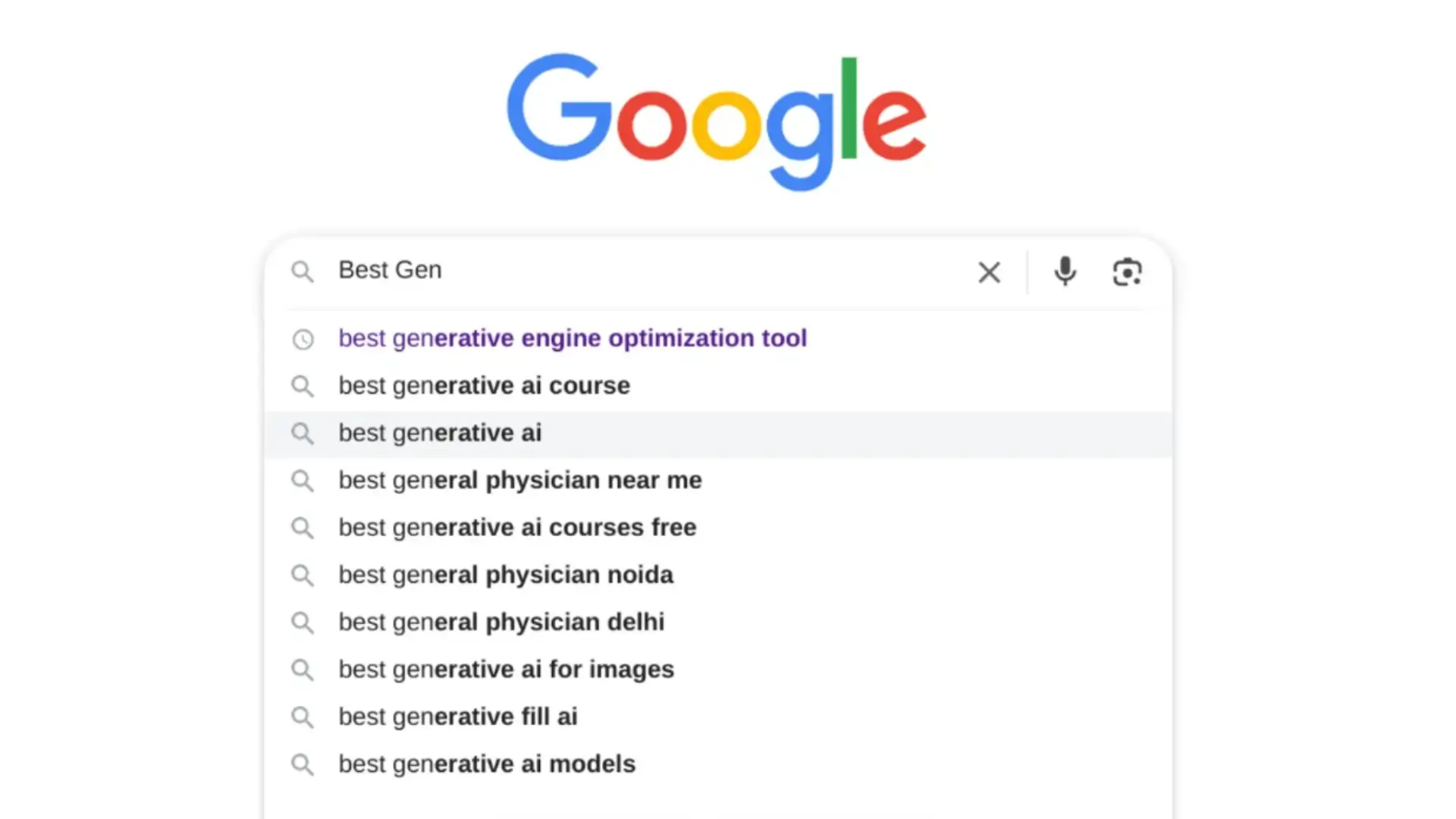
Auto-completion is a fundamental feature of AI-powered search engines and generative models. When users start typing a query, the system predicts and completes it based on common patterns and popular searches. Optimizing your content for auto-completion can dramatically increase your visibility and click-through rates.25
Why Optimize for Auto-Completion:
- Higher Visibility: If your keywords and phrases align with common auto-complete suggestions, your content is more likely to appear early in search predictions.
- User Intent Matching: Auto-completion reflects real user queries, helping you tailor your content to what users actually want to find.
- Increased Traffic Potential: Users tend to click on auto-complete suggestions because they offer quick, relevant answers.
How to Optimize for Auto-Completion:
- Research Common Phrases: Use tools like Google’s search bar, AnswerThePublic, or keyword planners to identify popular auto-complete suggestions in your niche.
- Use Natural Language: Write your content in conversational, natural phrasing that matches how people type queries.
- Incorporate Long-Tail Keywords: Auto-complete often suggests long-tail queries, so include these in your headings and body text.
- Answer Partial Queries: Address questions or phrases that users might start typing but not finish, ensuring your content completes their search intent.
- Keep Content Structured: Use clear headings, bullet points, and summaries to help AI extract relevant auto-complete-ready snippets.
Create Future-Proof Content
In the rapidly evolving world of AI-powered search and generative engines, creating content that remains relevant over time is crucial. Future-proof content not only withstands algorithm updates but also continues to attract traffic and earn citations from AI tools long after publication.
Why Future-Proof Content Matters:
- Longevity: Content that stays relevant saves you time and resources on frequent updates.
- Sustained Authority: Evergreen and well-researched content builds lasting trust with both AI engines and your audience.
- className="mt-2"Adaptability: Future-proof content is flexible enough to incorporate new trends, data, and insights without losing its core value.
How to Create Future-Proof Content:
- Focus on Evergreen Topics: Choose subjects that have lasting interest and importance within your niche.
- Use Data-Backed Information: Incorporate reliable statistics, studies, and references that remain valid over time or are regularly updated.
- Write with Depth and Detail: Comprehensive, well-structured content is more likely to be referenced by AI for a variety of related queries.
- Plan for Updates: Build a content refresh strategy to revisit and update facts, stats, and examples regularly.
- void Overly Trendy Jargon: While mentioning current trends can be helpful, don’t overload your content with fleeting buzzwords that may quickly become outdated.
Instead of writing “Top 10 Social Media Trends of 2025,” create a guide on “Core Principles of Social Media Marketing That Will Never Change,” and update it yearly with fresh data and examples.
By future-proofing your content, you make it a valuable asset that continually performs well in AI-driven search results, helping you maintain a competitive edge in Generative Engine Optimization.
Give Feedback to LLMs
One of the most underrated yet powerful strategies to improve your visibility in AI-driven search is actively engaging with Large Language Models (LLMs) by providing feedback. Many AI platforms learn and improve based on user interactions, including feedback on the quality, relevance, and accuracy of the answers generated.
Why Giving Feedback Matters:
- Influence AI Training: Your feedback helps fine-tune the AI’s understanding of quality content and reliable sources.
- Boosts Your Content’s Trustworthiness:Highlighting when your content is accurate or correcting misattributions can improve future referencing of your brand or work.
- Builds Relationships with Platforms: Some AI tools incorporate user feedback into their ranking and citation algorithms, indirectly benefiting your SEO.
How to Give Effective Feedback:
- Engage with AI Outputs: Whenever you use AI tools like ChatGPT, Perplexity, or others, take a moment to rate or comment on the responses related to your content or niche.
- Correct Misinformation: Politely flag errors or outdated info that affect your content’s reputation.
- Suggest Improvements: Provide constructive feedback that helps AI models understand nuances or emerging trends better.
- Participate in Beta Programs: Join user communities or beta testing groups for AI platforms to influence their development firsthand.
- Encourage Your Audience: Motivate your followers or readers to give feedback when your content is featured or referenced.
Example:

If ChatGPT cites your blog but misinterprets a key point, use the feedback option to clarify or provide a better summary. Over time, this improves how LLMs represent your content to others.
Target Zero-Click Searches
Zero-click searches are queries where users get the answer directly on the search results page or within an AI-generated response without clicking through to any website. In the era of AI-powered search, mastering zero-click optimization is essential to maximize your brand’s visibility and authority.
Why Target Zero-Click Searches?
- Instant Visibility: Your content can be featured prominently in AI snippets, knowledge panels, or answer boxes.
- Brand Authority:Even without clicks, being the source of the answer builds trust and recognition.
- Traffic Diversification: While clicks may decrease, zero-click presence increases your reach across multiple platforms and devices.
How to Optimize for Zero-Click Searches:
- Answer Questions Clearly and Concisely:Provide straightforward, well-structured answers that directly address common user queries.
- Use Structured Data Markup: Anticipate and answer popular questions in your niche to increase chances of being featured.29
- Create FAQ Sections: Implement schema to help search engines and AI better understand and extract your content.
- Leverage Lists and Tables: Formats like numbered lists or comparison tables are highly favored in featured snippets and AI answers.
- Focus on Featured Snippet Optimization: Research common snippet formats and tailor your content to match those patterns.
Example:
For a query like “What is Generative Engine Optimization?” a concise, bullet-point answer with key takeaways can get featured in AI-powered search results, even without a user clicking your page.
Publish Original Research Papers
Creating and publishing original research is one of the most powerful ways to establish authority and influence within your niche especially in the evolving landscape of Generative Engine Optimization (GEO). Original research offers unique, data-backed insights that AI engines and human audiences highly value.
Why Publish Your Own Research?
- Unique Content: Original data and findings cannot be easily replicated, giving you a distinct advantage over competitors.
- Higher Trust & Citations:AI models prefer to source information from primary research, boosting your chances of being cited in AI-generated responses.
- Thought Leadership:Publishing research positions you or your brand as an expert, increasing credibility and long-term authority.
- SEO Benefits:Research papers attract backlinks, references, and social shares, improving your overall search rankings.
How to Get Started:
- Identify a Niche Topic:Focus on a gap or emerging trend in your field that lacks comprehensive data or analysis.
- Design a Rigorous Study: Use clear methodologies and ensure data integrity to produce reliable results.
- Document Your Findings Clearly: Write with precision and provide visual aids like charts, graphs, and tables to enhance understanding.
- Publish on Reputable Platforms: Use academic journals, preprint servers like arXiv, or industry-specific publications to reach the right audience.
- Promote Your Research: Share summaries, blog posts, and social media snippets to increase visibility and engagement.
Optimize Like a Pro: Tips for Perplexity AI, ChatGPT, and Google AI Overview
AI-powered search and generative engines are changing the way we discover and interact with information every day. If you want your content to stand out and get noticed, it’s important to understand how these platforms work and how to optimize specifically for them. Since each AI model has its own way of processing and ranking content, tweaking your approach for Perplexity AI, ChatGPT, and Google AI Overview can really up your chances of being featured and seen by the right audience.
Optimization Tips for Perplexity AI
- Be Factual and Source-Backed:Perplexity AI prioritizes information that’s verifiable and well-cited. Always include credible references.30
- Keep Answers Concise: Short, clear, and precise content helps Perplexity generate effective summaries and answers.
- Use Lists and Bullet Points: Structured information is easier for Perplexity to extract and display.
- Address Popular User Queries: Focus on answering common questions in your niche to increase chances of featuring.
- Provide Clear Citations: Back up your claims with trustworthy sources to boost credibility.
ChatGPT
- Write Clear and Concise Answers: ChatGPT31 prefers straightforward language that’s easy to understand.
- Use Step-by-Step Explanations: Breaking down complex ideas into simple steps helps ChatGPT generate accurate responses.31
- Include Examples and Analogies: These improve the relatability and clarity of answers.
- Provide Context Early: Give relevant background information to help ChatGPT understand the topic better.
- Incorporate FAQs: Using question-answer formats increases your chances of appearing in AI-generated answers.
Optimization Tips for Google Overview
- Align Content with Search Intent: Google Overview pulls from authoritative, well-structured content that matches what users want.32
- Use Structured Data: Schema markup helps Google Overview extract key facts and display rich results.
- Focus on “How” and “Why” Content: Explanatory and detailed answers are favored
- Keep Content Fresh: Regular updates improve your chances of being referenced.
- Mention Recognized Entities: Referencing well-known people, places, or brands helps Google understand context.
Measuring Success in Generative Engine Optimization (GEO)
Measuring success in Generative Engine Optimization (GEO) sounds fancy, right? But really, it’s all about figuring out how well your content is doing in the world of AI-powered answers and generative search. Unlike old-school SEO, where you mostly check rankings and traffic numbers, GEO asks: Are AI engines actually picking you? Are people engaging with your content in these smart answers?
So, how do you know if you’re winning at GEO? Let’s break it down together:
Presence in AI-Generated Answers
- Track mentions in AI responses: Use tools or manual searches to see if your brand or content appears in AI-generated answers on platforms like ChatGPT, Bing AI, Perplexity, or Google’s AI snippets.
- Featured snippets & knowledge panels: Monitor whether your content gets selected as a direct answer or cited source in these AI responses.
Traffic from Generative Search Sources
- Referral traffic from AI tools: Use analytics tools (Google Analytics, or advanced tracking with AI monitoring tools) to identify how much traffic comes from AI-powered platforms or generative search features.
- User journey tracking: Understand how users interact after arriving via generative search results bounce rate, session duration, conversions.
Engagement Metrics on AI-Enhanced Content
- Content interaction: Measure how users engage with content optimized for GEO -comments, shares, dwell time, repeat visits.
- Conversational engagement: If your brand integrates with chatbots or AI assistants, track conversation length, user satisfaction, and completion rates.
Keyword & Intent Alignment in AI Queries
- Ranking for question-based queries:Monitor how your content answers natural language questions or prompts used by AI.
- Intent match accuracy: Ensure your content aligns closely with user intent that generative engines recognize.
Authority & Citation Metrics
- Backlinks from AI content: Check if your content is referenced or cited by AI-generated summaries or answers.
- Domain authority & topical relevance: These still matter because AI often prefers credible, authoritative sources.
Use of Specialized GEO Tools
- AI Monitoring tools: Platforms like AI Traffic Monitor can help track AI mentions, citation frequency, and performance in generative engines.
- SERP and AI engine tracking: Tools that track how AI engines display your content, how often it’s recommended, and in what context.
Conversion and Business Impact
- Lead generation and sales from GEO traffic: Track how AI-driven traffic contributes to actual business outcomes.
- Brand awareness lift: Surveys or brand tracking studies can assess if AI-generated answers boost your brand recall.
GEO Success Metrics
| Metric | What to Measure | Tools/Methods |
|---|---|---|
AI Answer Presence | Mentions in AI responses, snippets | Manual search, AI Monitoring Tools |
Traffic from AI Sources | Visits from AI platforms | Google Analytics, AI Traffic Monitors |
User Engagement | Bounce rate, dwell time, shares | Web analytics tools |
Keyword Intent Alignment | Ranking for natural questions | SEO & AI search analytics |
Authority & Citation | AI citations, backlinks | Backlink tools, AI monitoring |
Conversion Metrics | Leads, sales, brand awareness | CRM, analytics, surveys |
Tools That Enhance the Generative Engine Optimization (GEO) Process
As AI-generated answers become the new front door to the internet, Generative Engine Optimization (GEO) is reshaping how brands show up in smart tools like ChatGPT, Perplexity, Gemini, and many others. But here’s the thing crafting great content alone won’t cut it anymore. To truly dominate AI-powered search, you need the right tools on your side.33
Ready to power up your GEO game? Here’s a handpicked list of the most powerful tools shaping AI visibility in 2025 tools designed to help you track, optimize, and shine in the evolving AI search landscape.
AI Monitor – The GEO Powerhouse
AI Monitor offers real-time tracking of your brand’s visibility in AI search platforms such as Google’s AI Overview, ChatGPT, Claude, and Perplexity. It monitors prompts, sentiment, citations, and competitive keyword coverage, making it the most complete and useful GEO platform on the market.33
Used by top agencies to drive 500%+ visibility gains.
Semrush – The Trusted SEO Tool with GEO Add-Ons
Semrush rolled out GEO-friendly tweaks like prompt tracking and AI-answer detection. It’s a smooth way for traditional SEO professionals to integrate GEO without rebuilding their stack.
Starter plans kick off at $99/month.
Otterly.AI – The Budget-Friendly Option
Otterly.AI is an affordable tool that provides basic prompt visibility and keyword-to-prompt matching.It’s easy to use and offers fast setup, though results can be inconsistent.
If you’re in the early stages of testing geo-targeted campaigns, this approach pays off.
Profound – The Enterprise Intelligence Engine
Profound delivers high-end AI behavior mapping, brand risk forecasting, and prompt-level insights for large organizations.If you need deep analysis and long-term strategy planning, this is your tool.
Requires premium licensing and advanced onboarding.
BrandRank.ai – The Reputation Guardian
BrandRank.ai offers a hybrid approach: AI monitoring paired with human review to detect brand misrepresentation or legal risk in generative answers. Especially valuable for finance, healthcare, or government orgs.
Ziptie.dev – The Developer’s Playground
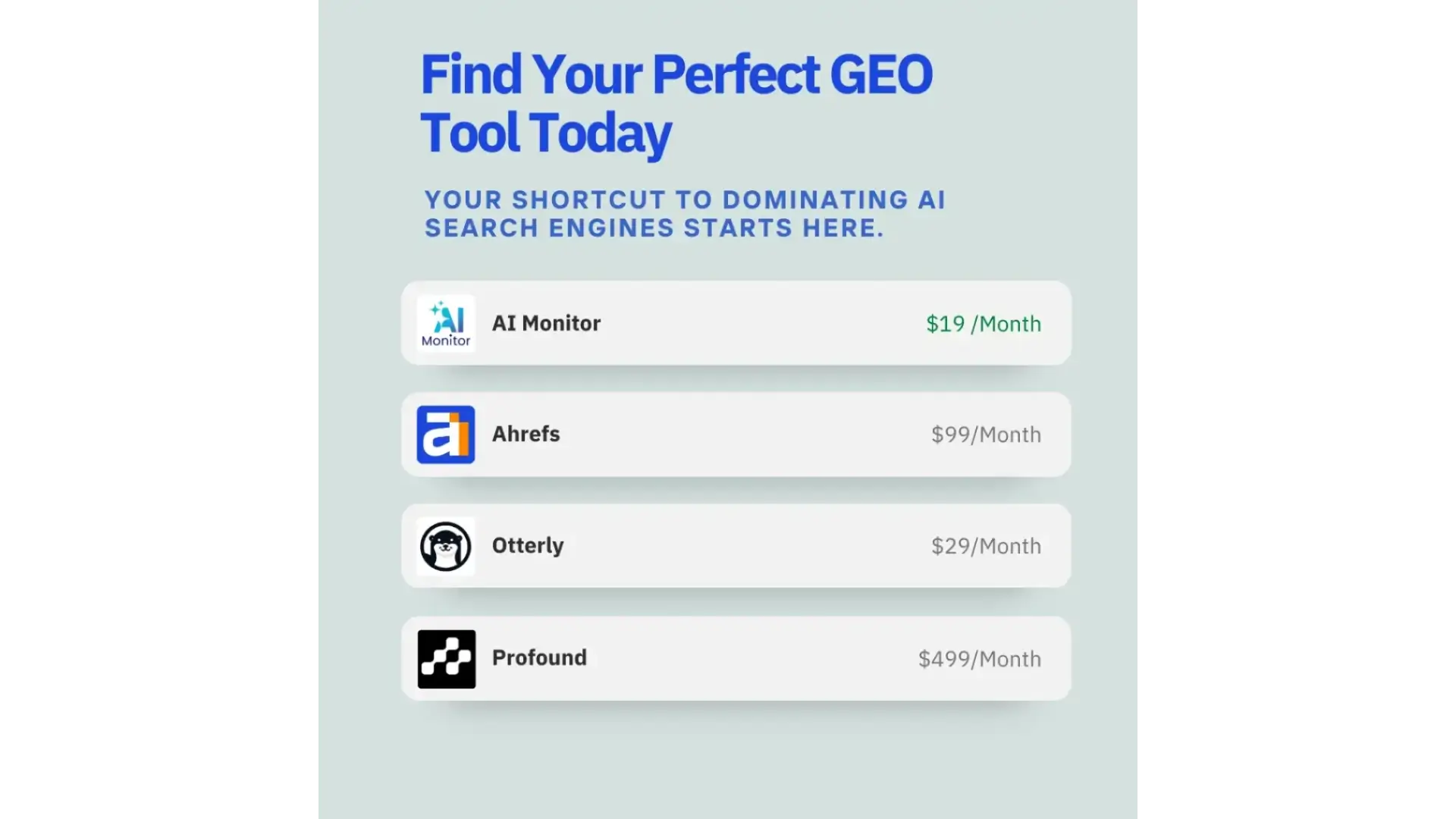
Ziptie.dev is a developer-first API toolkit for tracking generative engines at a technical level.You can build your dashboards, alerts, and pipelines to follow brand, product, or keyword prompts as they evolve.
Ideal for custom solutions and AI research.
Did you know there are over 50+ GEO tools already shaping the future of AI-driven search?
We’ve put together a curated list of the most powerful Generative Engine Optimization tools on the planet, your one-stop resource to stay ahead in the game.
Got a GEO tool we haven’t included yet? Drop us an email, and we’ll make sure it gets the spotlight it deserves
Real-World GEO Success Stories
A Personal Story: How GEO Became My Unexpected Calling
So here’s the thing back then, I was actually a lawyer by profession. When my startup popped up in an AI-generated negative mention, I wasn’t just annoyed; I was ready to lawyer up! I thought, “This is personal. Somebody’s gotta pay!” I was gearing up for legal action, drafting imaginary court speeches in my head.
But then, reality hit me like a truck. It wasn’t personal at all. There’s no sneaky villain behind the curtain, no evil mastermind. It’s just AI doing what AI does crawling through heaps of data, piecing things together without any real ‘face’ or intent. It’s like blaming your GPS for taking you the long way home it’s just following the data, no offense meant.
That’s when I had my lightbulb moment: instead of fighting AI with lawsuits, why not learn its language? How does it pick what to show and what to ignore? How can I help my brand and others to become the kind of content AI wants to recommend? Enter Generative Engine Optimization (GEO), my new obsession and, honestly, the ultimate game-changer.
Fast forward to now, and here’s what I’ve seen:
- Clients enjoying a sweet 40% jump in traffic from AI platforms like ChatGPT and Google AI Overview.
- Content that includes just a couple of solid stats is47% more likely to get picked by AI answers.
- Joining niche forums like Reddit has given some brands a 2.9x boost in AI visibility.
Turns out, combining a lawyer’s eye for detail with a passion for AI tech makes a pretty good combo. GEO isn’t just some fancy acronym it’s the new way to be seen and heard in today’s AI-driven world. And I’m here to help others crack the code, with maybe a little bit less legal drama and a lot more smart strategy.
Relixir & a YC-Backed Fintech
A fintech startup working with Relixir launched a strategic GEO initiative including autonomous content publishing and smart question modeling and flipped 200+ ChatGPT queries to the #1 spot within 30 days. This produced $2.3M in additional pipeline and a 47% increase in qualified leads, proving the rapid ROI potential of GEO.34
Reddit-Featured SaaS Startup
A SaaS startup shared on Reddit how they reverse-engineered ChatGPT recommendations through competitive query analysis and structured, AI-friendly “solution guides.” Within six weeks, they became ChatGPT’s top recommendation in their category, achieved a 156% increase in demo requests, and gained consistent visibility across ChatGPT, Perplexity, and Claude.
Healthline’s Healthcare SEO Overhaul
In the healthcare sector, Healthline restructured its articles for AI consumption adding FAQ formats, expert credentials, and schema markup and saw a 218% rise in AI citations and a 43% uplift in traffic from generative search platforms.
HubSpot’s Data-Driven Authority Play
B2B leader HubSpot published original research reports formatted for AI readability clear stats, visuals, and insights. This paid off: they now receive 15,000+ AI citations yearly and enjoy a 76% year-over-year surge in referral traffic from AI platforms.
Conclusion
In today’s fast-evolving digital landscape, Generative Engine Optimization (GEO) is the game changer brands can’t afford to ignore. As AI-powered search tools like ChatGPT, Perplexity, and Gemini redefine how users find information, your AI search visibility hinges on more than just producing great content it demands smart optimization and the right GEO tools.
By leveraging advanced AI-powered tools tailored for GEO, you can track your presence in generative answers, align your content with natural user intent, and build authority that AI engines trust and cite. This strategic approach boosts your chances of being featured in AI-generated responses, driving quality traffic and real business growth
Ready to dominate AI search in 2025? Start using these essential GEO tools today and position your brand as a trusted source in the new era of AI-driven discovery. The future is generative make sure you’re leading, not following.
Works Cited
- What Is Generative Engine Optimization (GEO)?, accessed August 12, 2025,
https://searchengineland.com/what-is-generative-engine-optimization-geo-444418 - Similarweb: No Clicks From Google Grew From 56% to 69% Since AI Overviews, accessed August 12, 2025,
https://www.seroundtable.com/similarweb-google-zero-click-search-growth-39706.html - AI Overviews Reduce Clicks: What It Means for SEO, accessed August 12, 2025,
https://ahrefs.com/blog/ai-overviews-reduce-clicks - What Is Generative Engine Optimization (GEO)?, accessed August 12, 2025,
https://writesonic.com/blog/what-is-generative-engine-optimization-geo - Generative Engine Optimization (GEO): The Future of Search Is Here, accessed August 12, 2025,
https://www.forbes.com/councils/forbesagencycouncil/2025/01/02/generative-engine-optimization-geo-the-future-of-search-is-here/ - What’s Generative Engine Optimization (GEO) & How To Do It, accessed August 12, 2025,
https://foundationinc.co/lab/generative-engine-optimization - How Generative Engine Optimization (GEO) Rewrites the Rules of Search, accessed August 12, 2025,
https://a16z.com/geo-over-seo/#:~:text=In%20the%20SEO%20era%2C%20visibility,user%20experience%20engagement%2C%20and%20more. - The History of SEO: From 1990 to Today - Reboot Online, accessed August 12, 2025,
https://www.rebootonline.com/blog/seo-history/#:~:text=This%20update%20saw%20the%20first,quality%20content%2C%20over%20the%20sheer - The Emergence of Generative Engine Optimization (GEO) - GrowthRocks, accessed August 12, 2025,
https://growthrocks.com/blog/the-emergence-of-generative-engine-optimization-geo/#:~:text=SEO%20(and%20similarly%20ASO%20or,via%20professionally%20made%20link%20building) - From SEO to GEO: how AI is changing search in 2025 - ClickForest, accessed August 12, 2025,
https://www.clickforest.com/en/blog/geo-seo-evolution#:~:text=GEO%3A%20the%20new%20reality%20of,answers%20based%20on%20multiple%20sources - Will GEO replace SEO – or become part of it? - Search Engine Land, accessed August 12, 2025,
https://searchengineland.com/geo-replace-seo-460397#:~:text=The%20move%20to%20all%2Din,thing%20as%20traditional%20search%20vs. - How Generative Engine Optimization (GEO) Rewrites the Rules of Search, accessed August 12, 2025,
https://a16z.com/geo-over-seo/#:~:text=Semrush%20also%20has%20a%20dedicated,adapting%20to%20the%20GEO%20era - From SEO to GEO: How AI is redefining positioning - Telefónica, accessed August 12, 2025,
https://www.telefonica.com/en/communication-room/blog/from-seo-to-geo-how-ai-is-redefining-positioning/ - SEO Is Dead. Say Hello to GEO. - New York Magazine, accessed August 12, 2025,
https://nymag.com/intelligencer/article/seo-is-dead-say-hello-to-geo.html#:~:text=Generative%2Dengine%20optimization%20%E2%80%94%20also%20known,developing%20AI%20chatbots%20that%20have - Generative Engine Optimization “GEO”,accessed August 12, 2025,
https://arxiv.org/abs/2311.09735 - GEO vs SEO: Key Differences, Optimization Strategies, and Future Trends
https://getaimonitor.com/geo-vs-seo-key-differences/ - How Good SEO Impact GEO | A Comprehensive Guide for 2025
https://getaimonitor.com/how-good-seo-impact-geo-a-comprehensive-guide/ - Top 10 generative engine optimization tool
https://getaimonitor.com/top-10-generative-engine-optimization-tools/ - The Future of Search: Understanding Entities and the Shift from Keywords to Concepts
https://getaimonitor.com/the-future-of-search-understanding-entities-and-the-shift-from-keywords-to-concepts/ - Future Proof Your Content: Top 4 Strategies to Outsmart AI and Dominate Search
https://getaimonitor.com/future-proof-your-content-with-these-strategies-to-dominate-ai/ - News & Media Partnership: A Strategic Boost for Generative Engine Optimization (GEO) in 2025
https://getaimonitor.com/media-partnership-a-strategic-boost-for-generative-engine-optimization-geo/ - 11 Secret Generative Engine Optimization Techniques | Only We Know
https://getaimonitor.com/top-11-generative-engine-optimization-techniques/ - How to Fix AI Crawlability and Boost Your Site’s Performance in Search Engines
https://getaimonitor.com/fix-ai-crawlability-and-boost-your-sites-performance-in-search-engines/ - Leverage Reddit for Generative Engine Optimization: Boost Your Brand with Strategic Reddit Geo Marketing
https://getaimonitor.com/leverage-reddit-for-generative-engine-optimization/ - Auto Complete Prompts Hack: Predict The User’s Query Before They Think
https://getaimonitor.com/auto-complete-prompts-hack/ - Use Quotes Like a Pro | Best Hack for GEO in 2025
https://getaimonitor.com/use-quotes-like-a-pro-best-hack-for-geo/ - Step by Step Guide: How to Create and Implement an llms.txt File
https://getaimonitor.com/step-by-step-to-create-and-implement-llms-txt-file/ - Importance of Statistics in GEO to Dominate AI Search Results (and Captivate Readers)
https://getaimonitor.com/importance-of-statistics-in-geo-to-dominate-ai-search/ - How Zero-Click Searches are Revolutionising SEO and GEO
https://getaimonitor.com/how-zero-click-searches-are-revolutionising-seo-and-geo/ - How to Get Featured by Perplexity AI in 2025: The Complete Interactive Guide
https://getaimonitor.com/how-to-get-featured-by-perplexity-ai-in-2025-the-complete-interactive-guide/ - ChatGPT SEO: How to Rank in ChatGPT Responses in 2025 12, 2025,
https://getaimonitor.com/chatgpt-seo-how-to-rank-in-chatgpt-responses-in-2025/ - How to Get Featured in Google’s AI Overview? Tools and Strategies for 2025
https://getaimonitor.com/how-to-get-featured-in-googles-ai-overview-tools-and-strategies-for-2025/ - Generative engine optimization tool
https://getaimonitor.com/top-10-generative-engine-optimization-tools/ - Case Study: How a YC-Backed Fintech Flipped 200+ ChatGPT Queries to #1 in 30 Days with Relixir
https://relixir.ai/blog/blog-yc-fintech-chatgpt-queries-relixir-case-study?
